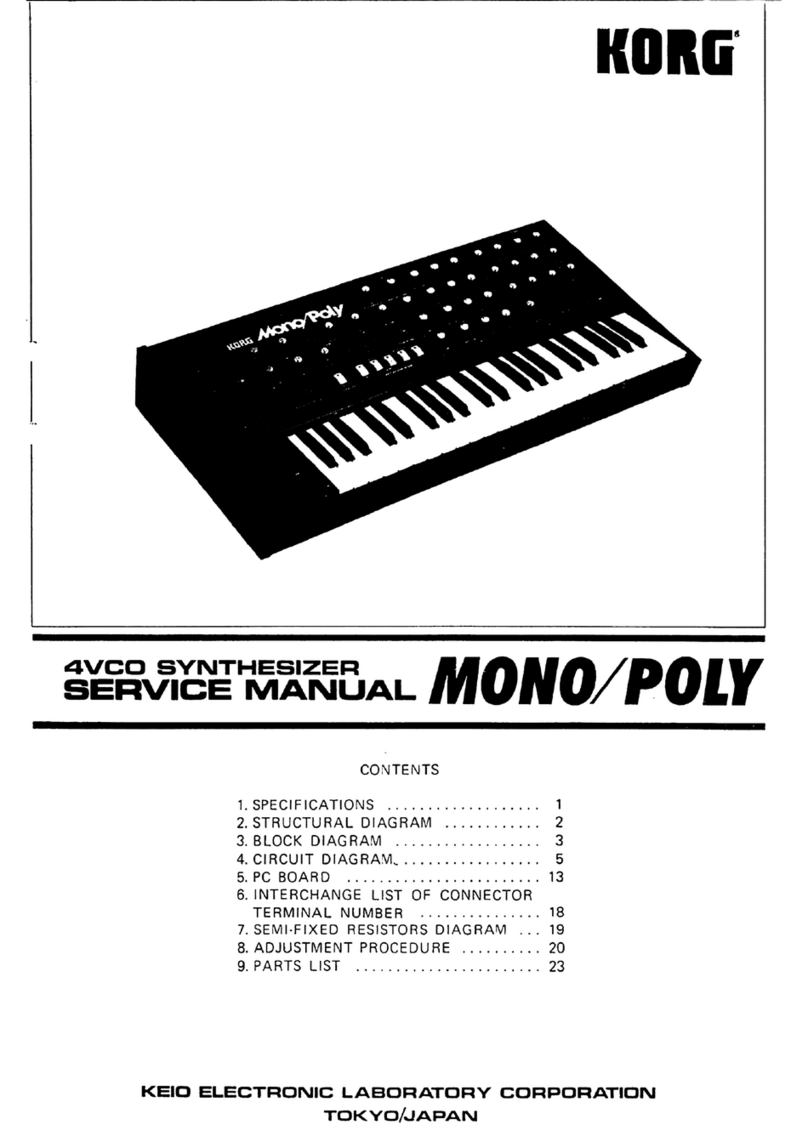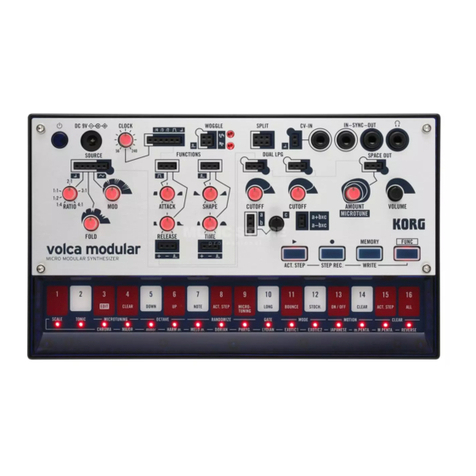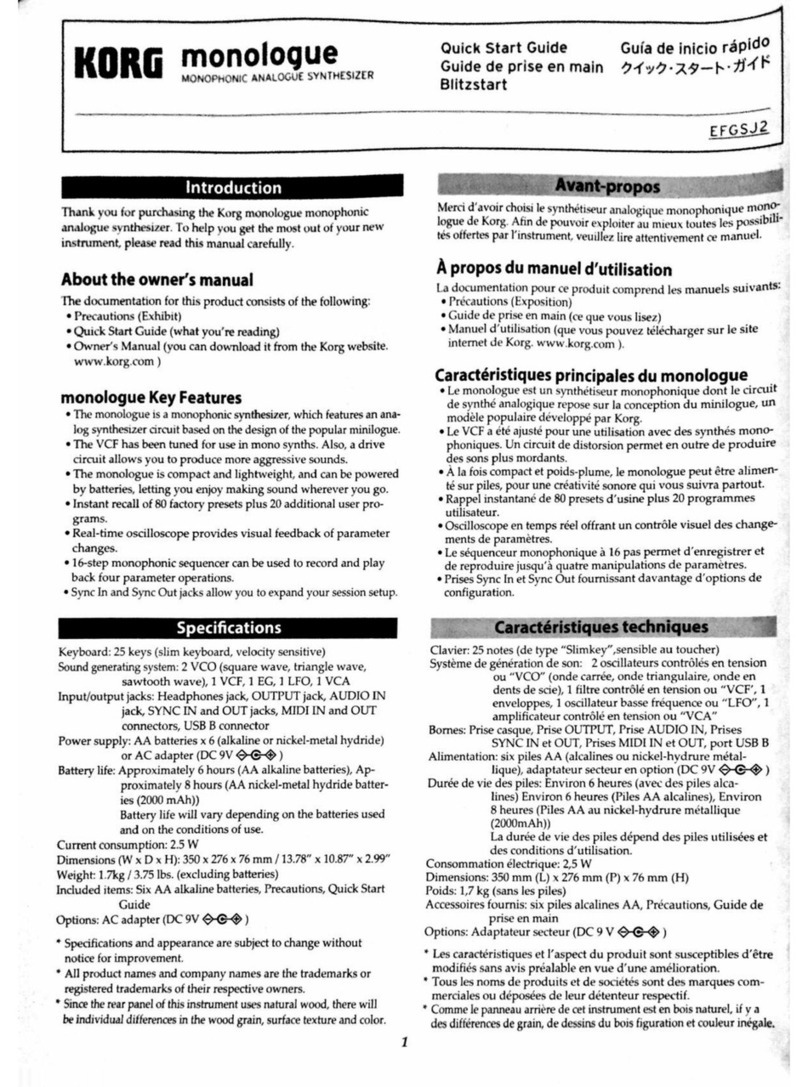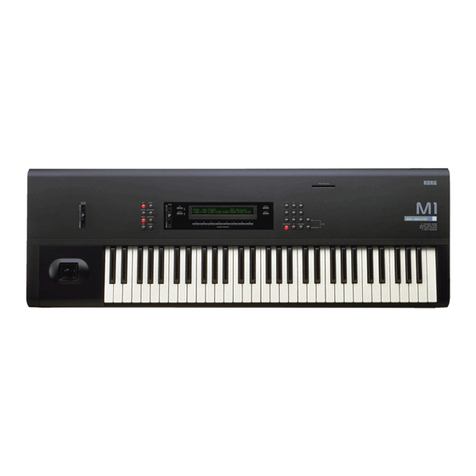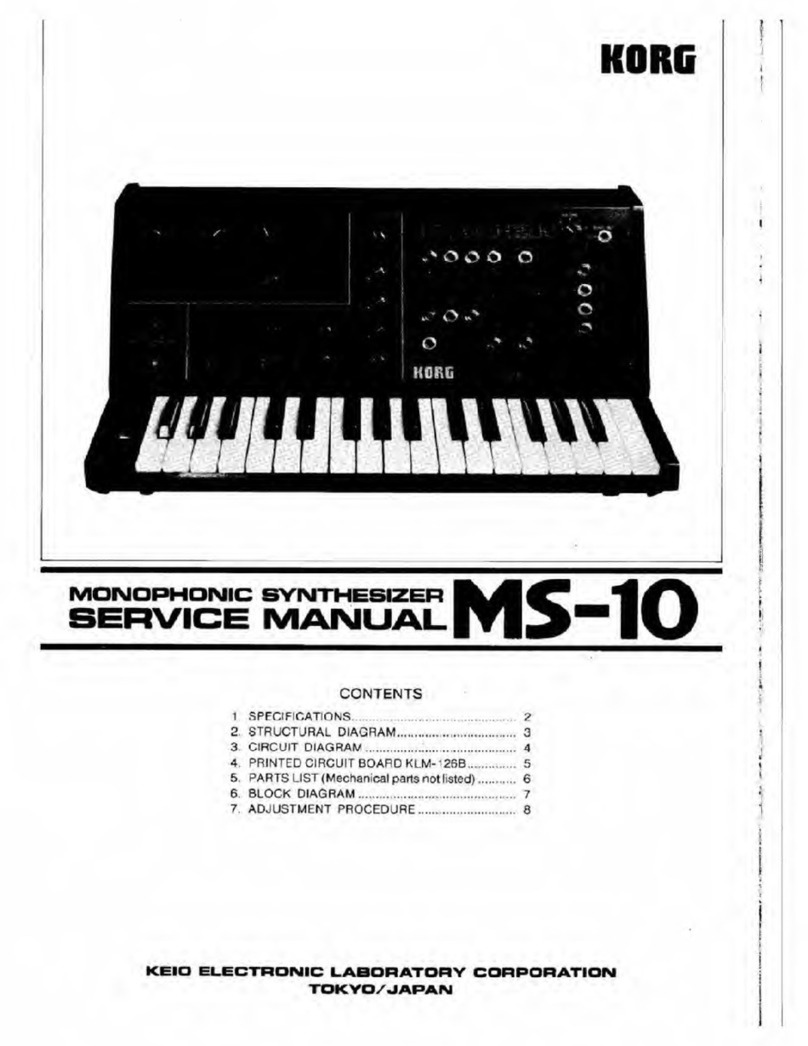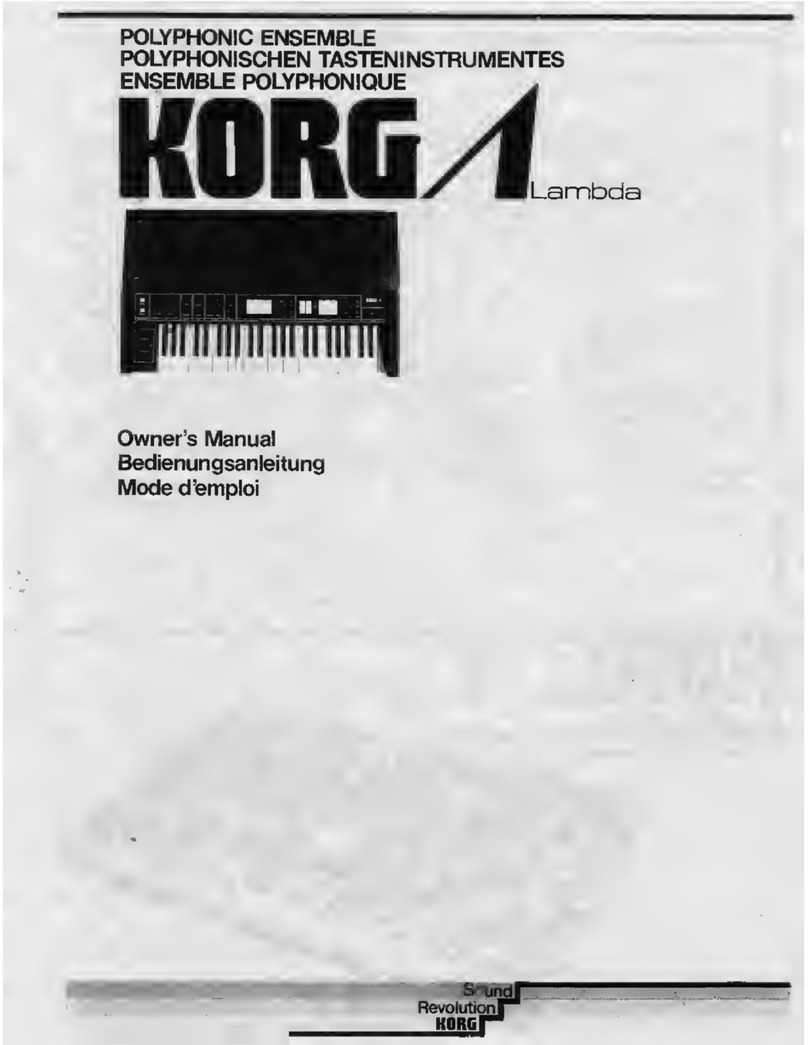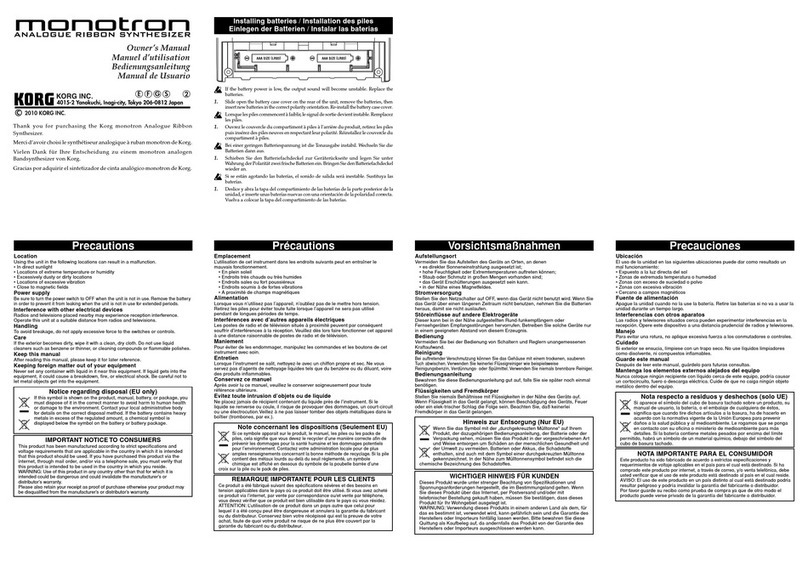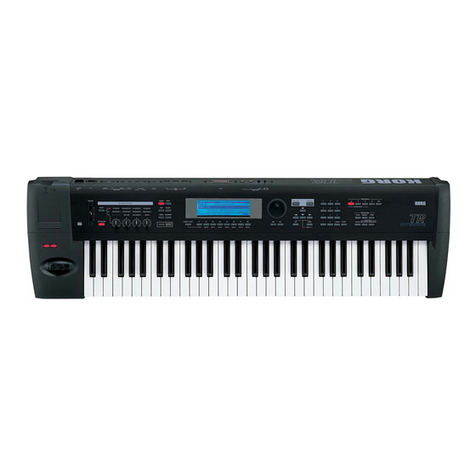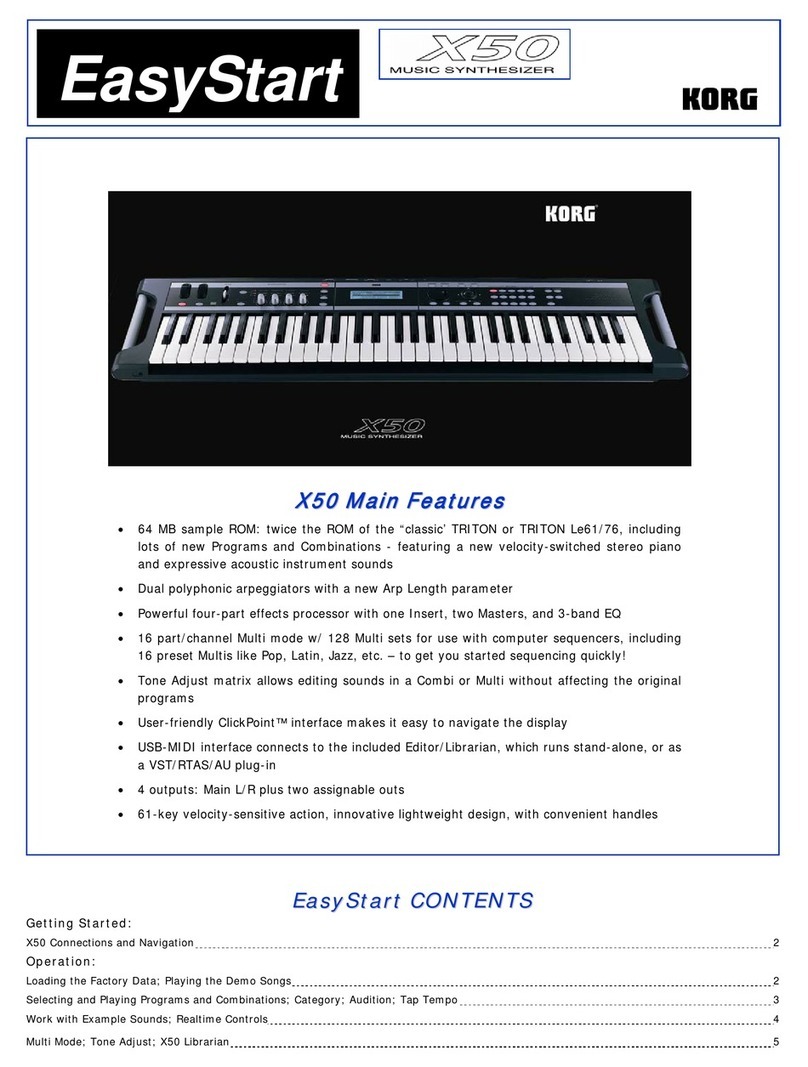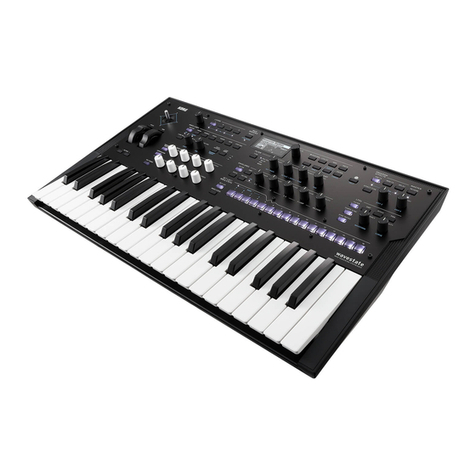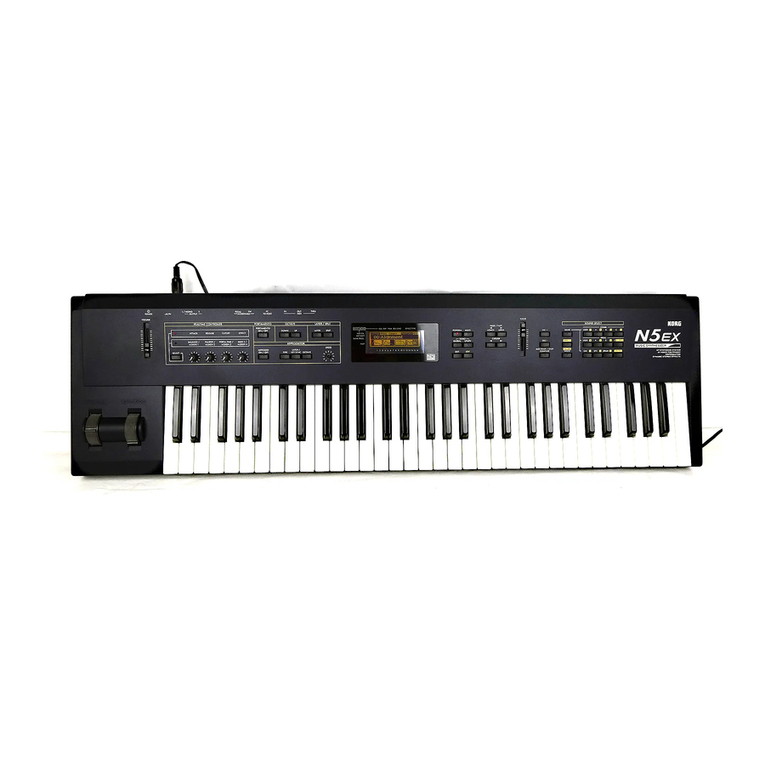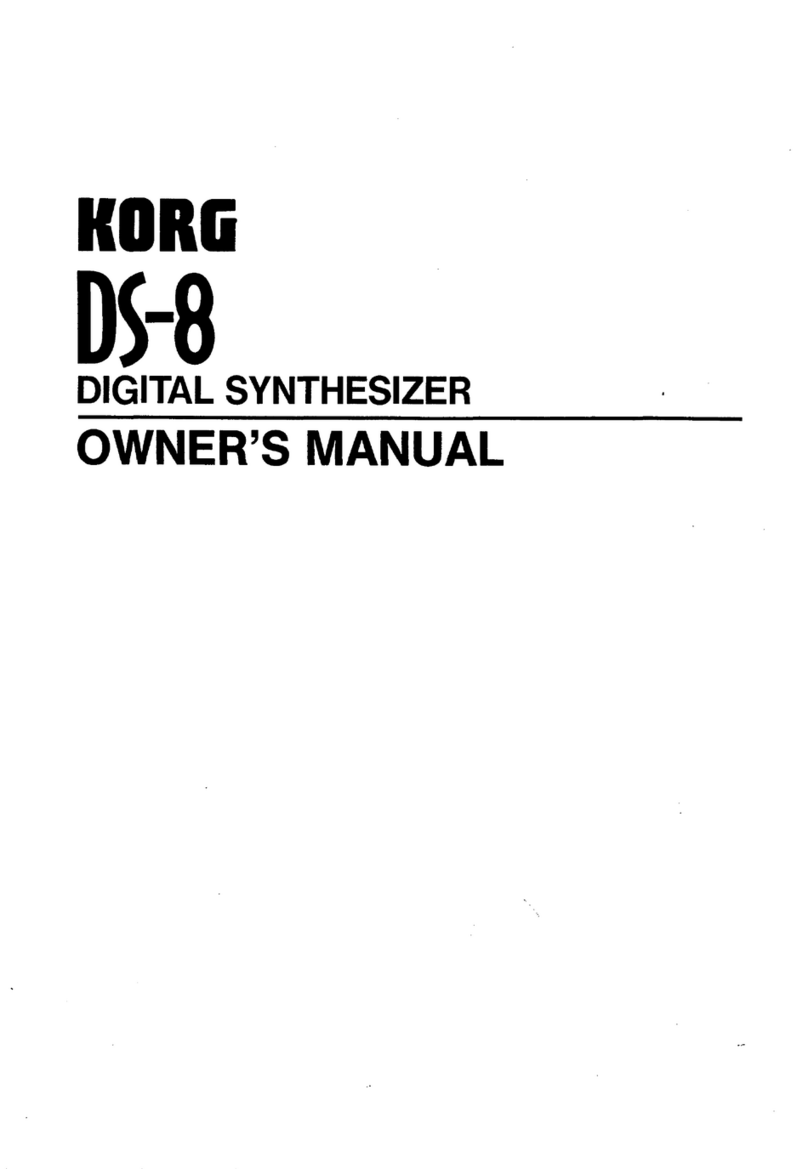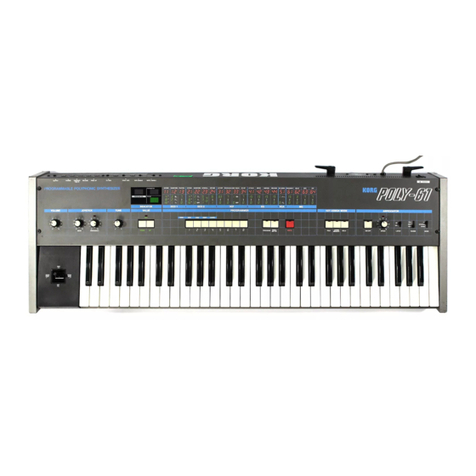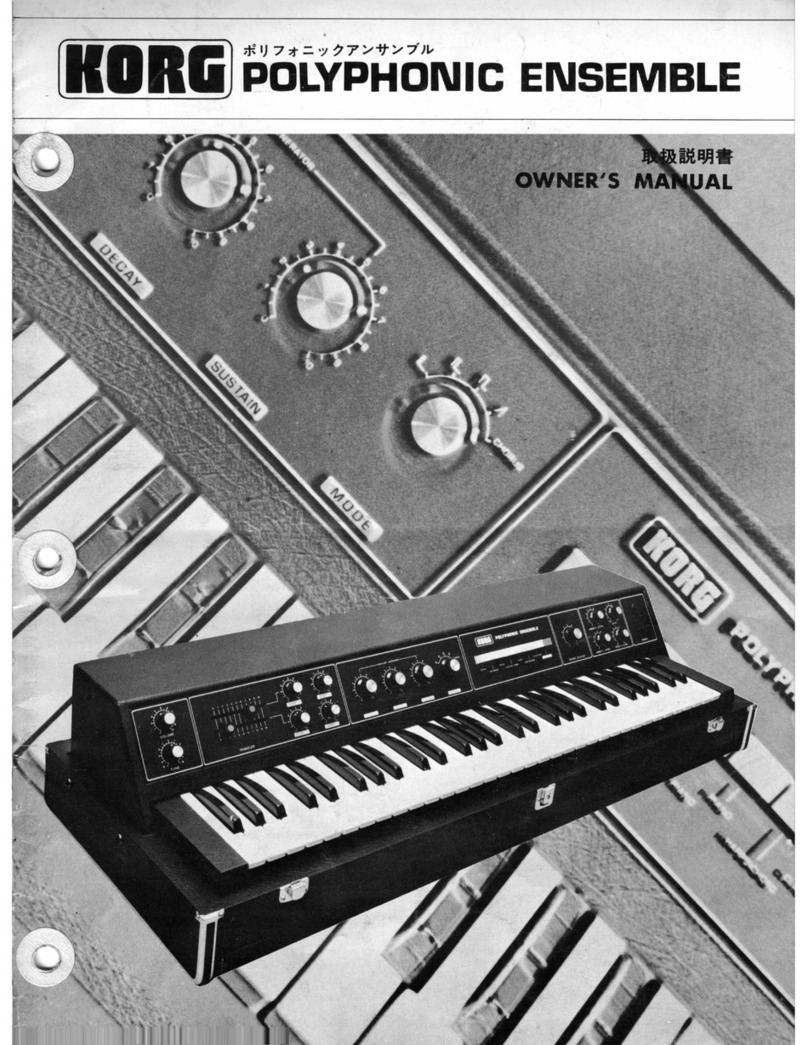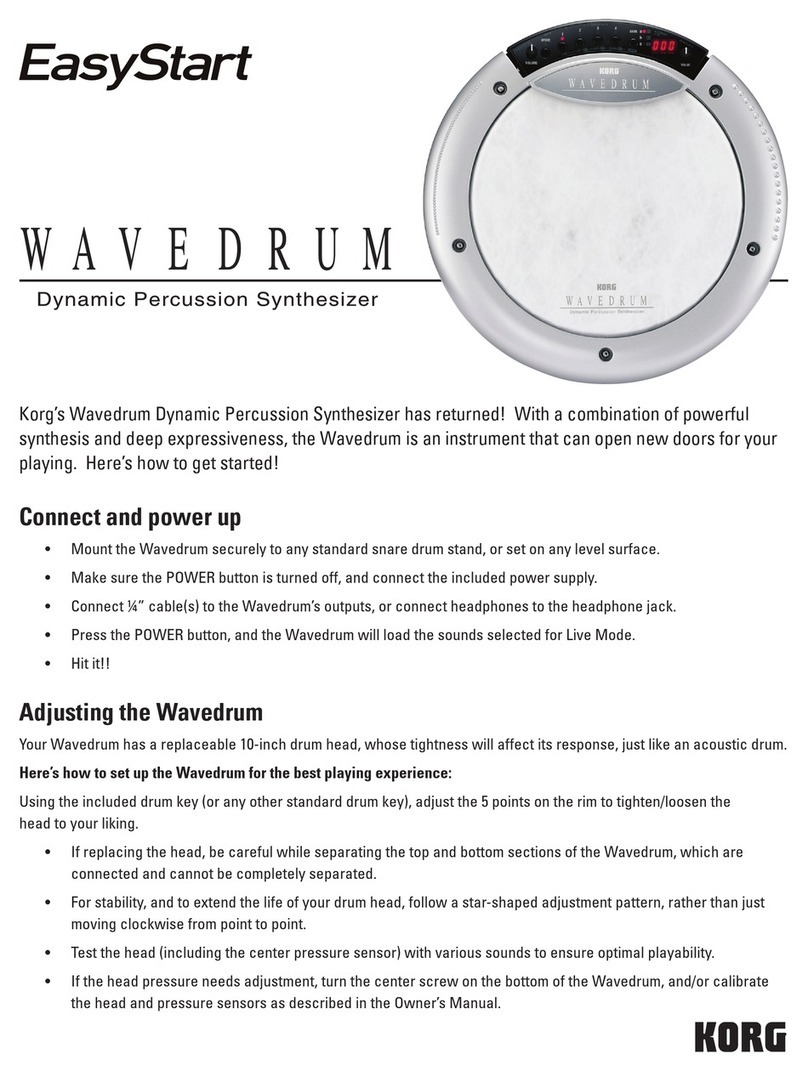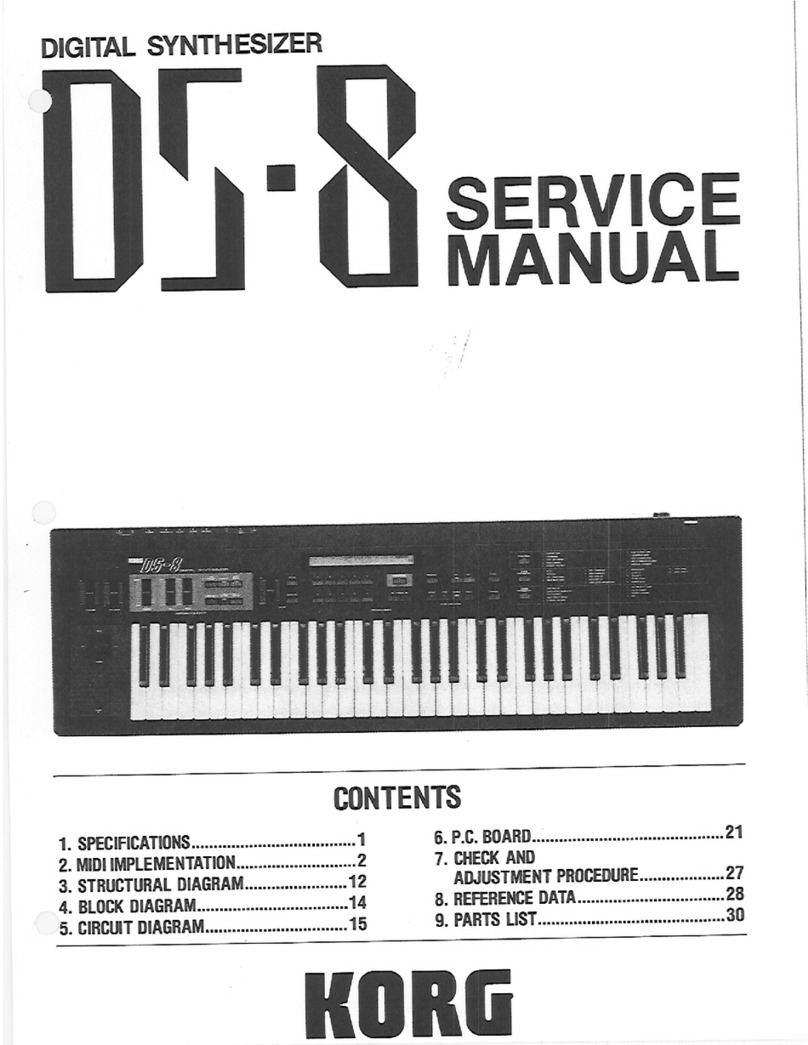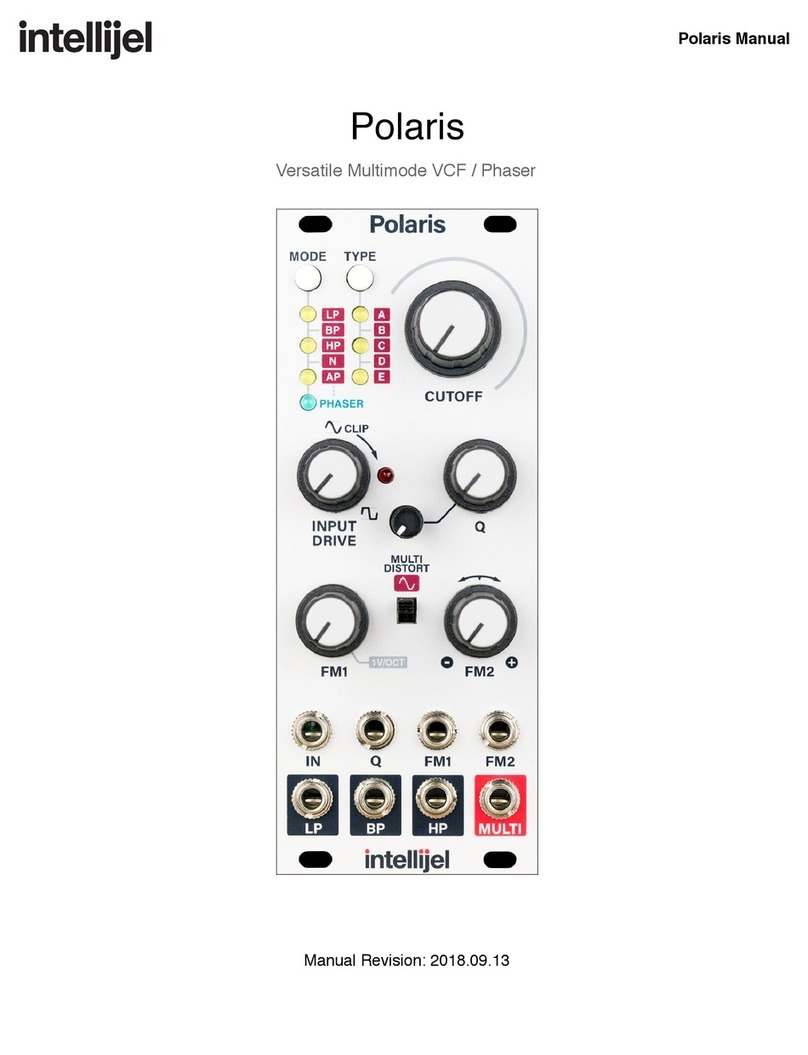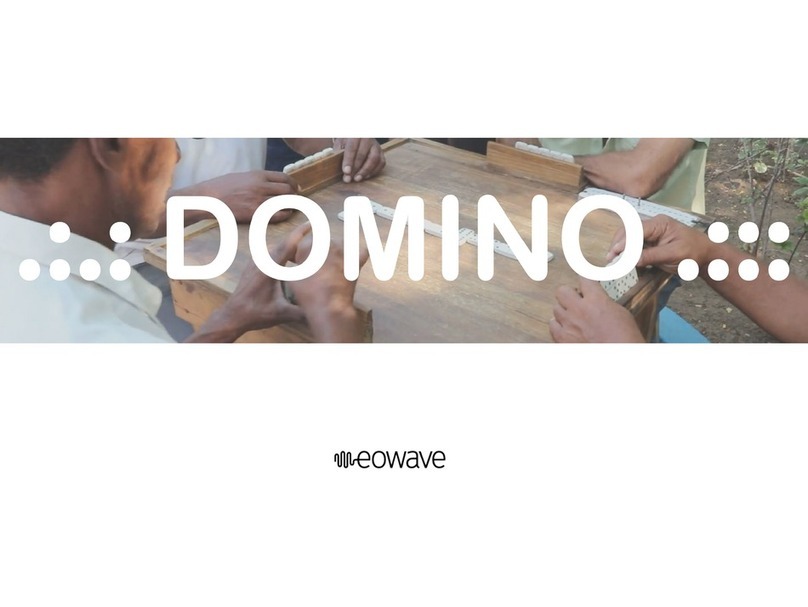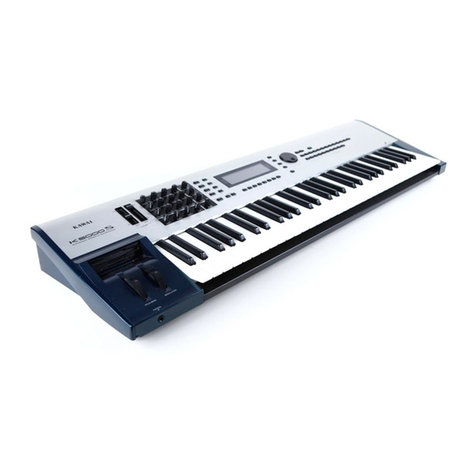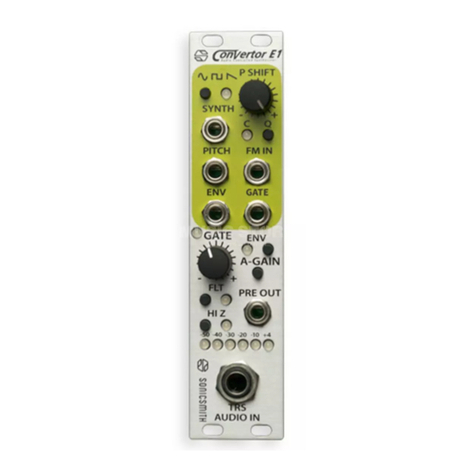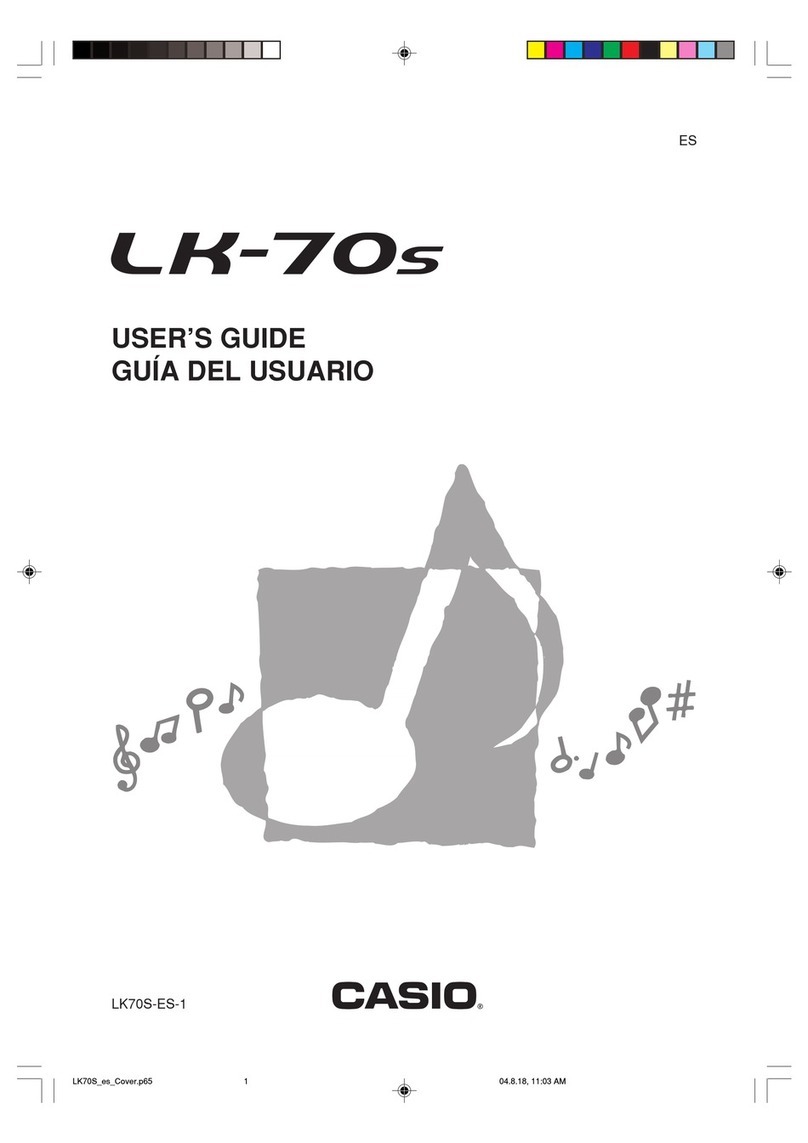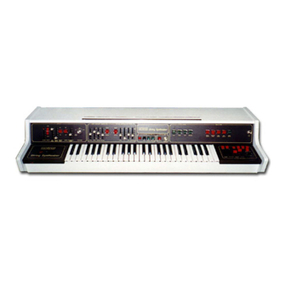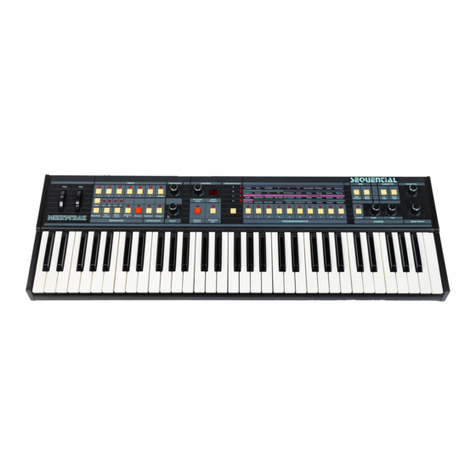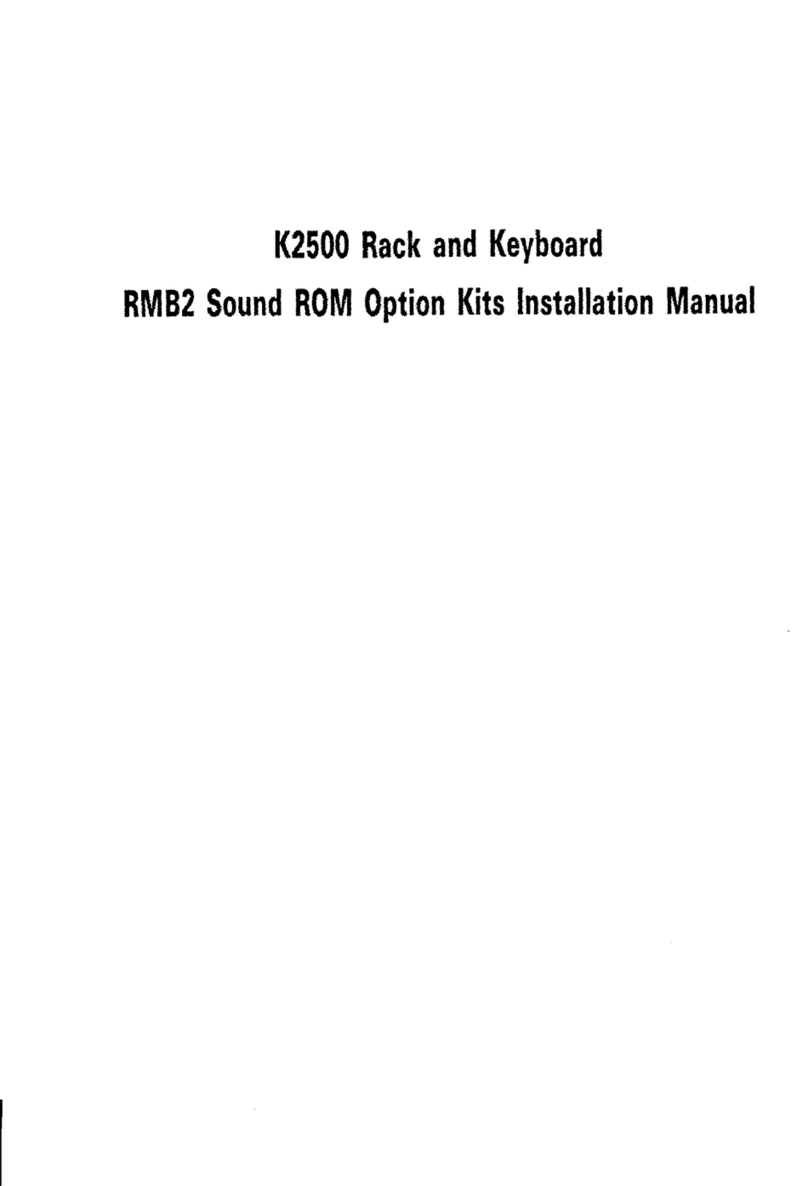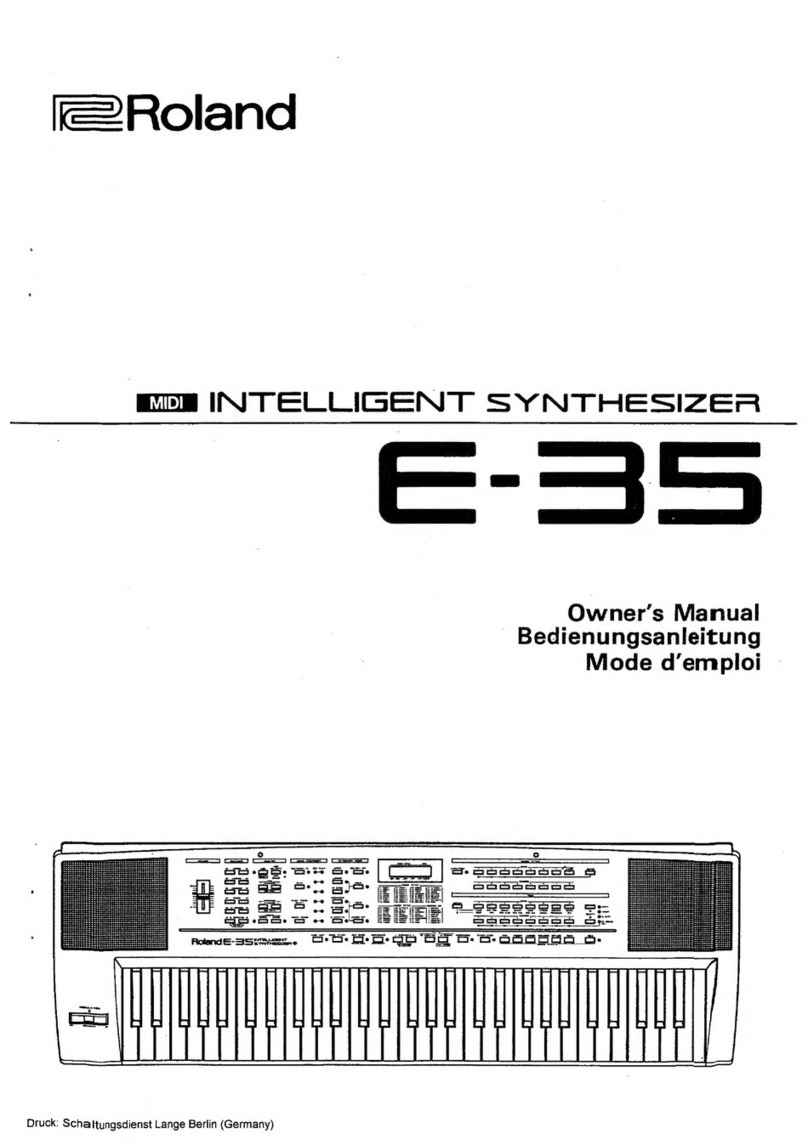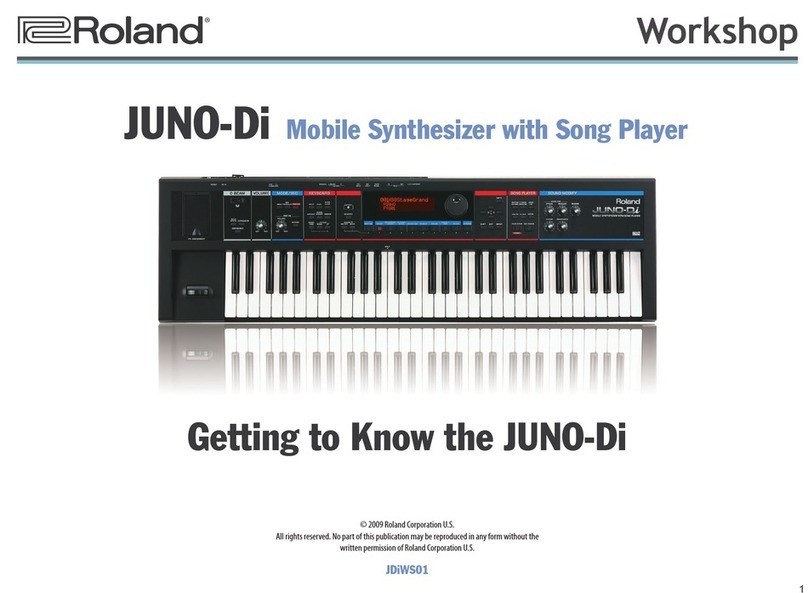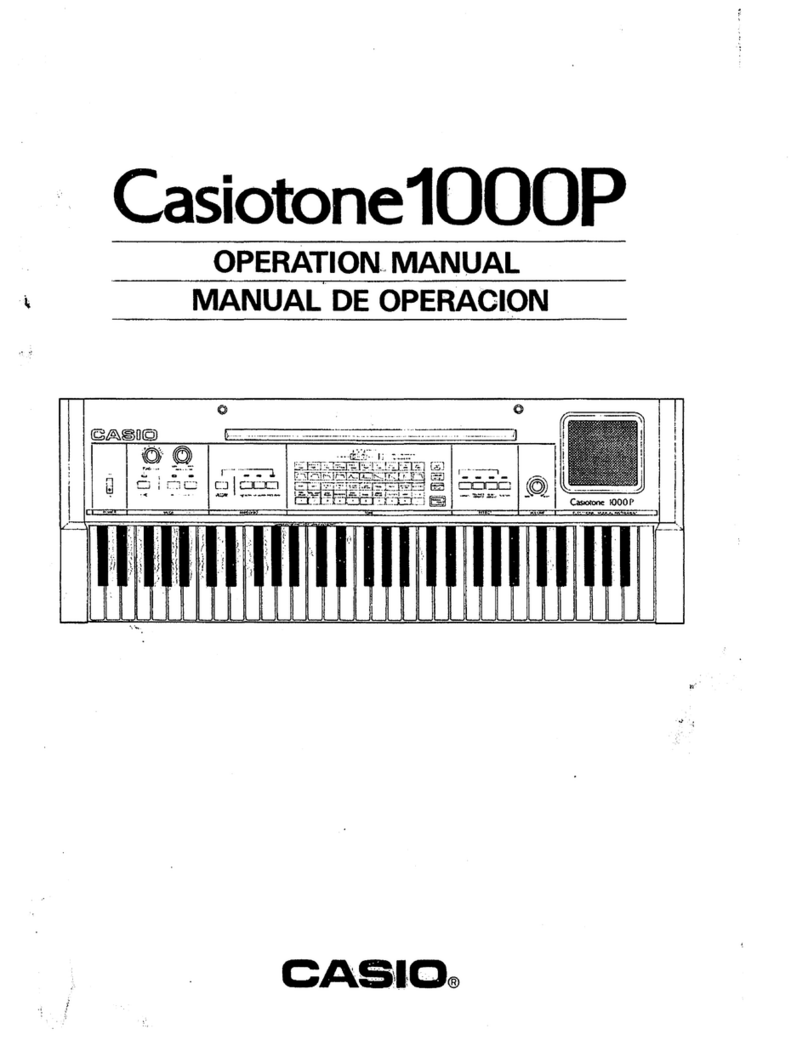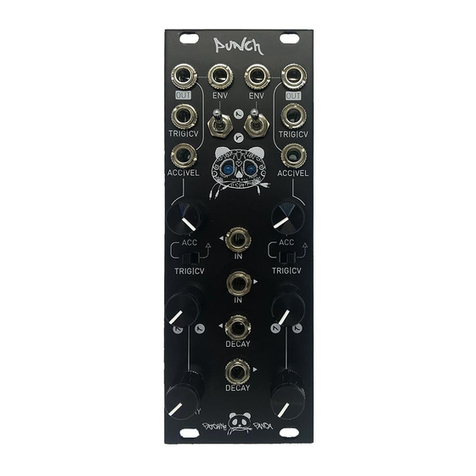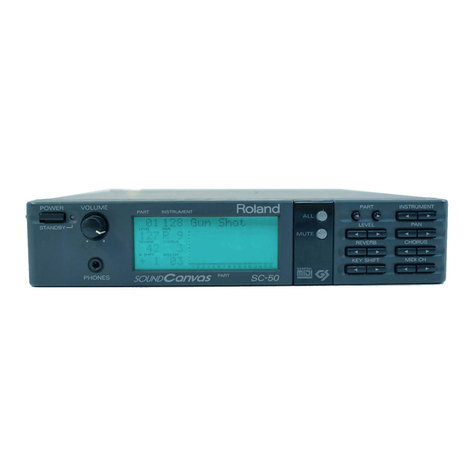Korg Karma User manual

4E


iii
This
“Parameter Guide”
contains explanations and other
information regarding the operations of the parameters and
settings on this instrument. The explanations are organized
by mode, page, and tab. Explanations and other information
on the effects and their parameters are also provided for
each effect.
Refer to this guide when an unfamiliar parameter appears in
the display, or when you need to know more about a partic-
ular function.
Conventions in this manual
Abbreviations for the manuals BG, PG, GE, VNL
References to the manuals included with the KARMA are
abbreviated as follows.
BG
: Basic Guide
PG
: Parameter Guide
GE:
KARMA GE Guide
VNL
: Voice Name List
Switches and knobs [ ]
References to the keys, dials, and knobs on the KARMA’s
panel are enclosed in square brackets [ ].
Parameters in the LCD display screen “ ”
Parameters displayed in the LCD screen are enclosed in
double quotation marks “ ”.
Boldface type
Parameter values are printed in boldface type.
Content that is of particular importance is also printed in
boldface type.
Procedure steps
1
2
3
...
Steps in a procedure are listed as
1
2
3
...
☞
p.
■
,
☞
BG p.
■
,
☞
GE p.
■
,
☞■
.
■
–
■
From the left, these symbols indicate a reference page in the
Parameter Guide, a reference page in the Basic Guide, a ref-
erence to the GE Guide, and a parameter number.
Symbols , , , , ,
These symbols respectively indicate cautions, advice, MIDI-
related explanations, a parameter that can be selected as an
alternate modulation source, a parameter that can be
selected as a dynamic modulation source, and a parameter
that can use the BPM/MIDI Sync function.
Example screen displays
The values of the parameters shown in the example screens
of this manual are only for explanatory purposes, and may
not necessary match the values that appear in the LCD
screen of your instrument.
MIDI-related explanations
CC#
is an abbreviation for Control Change Number.
In explanations of MIDI messages,
numbers in square
brackets [ ]
always indicate hexadecimal numbers.
How to read the “Parameter Guide”
(example)
About this manual
PROG 5.3: Ed–LFOs
5.3–1: OS1LFO1 (OSC1 LFO1)
5.3–1a
5.3–1b
5.3–1c
5.3–1d
5.3–1a: OSC1 LFO1
Waveform [Triangle 0…Random6 (Vect.)]
■5.3–1d: UTILITY
Swap LFO 1&2
Here you can make settings for the LFO that can be used to
cyclically modulate the Pitch, Filter, and Amp of oscillators 1
and 2. There are two LFO units for each oscillator. By setting
the LFO1 or LFO2 Intensity to a negative (–) value for Pitch,
Filter, or Amp, you can invert the LFO waveform.
Indicates settings for the “OSC1 LFO1,”which is the first
LFO that can be used for oscillator 1.
☞“Write Program”(1.1–1c)
For details on how to select the desired utility function,
refer to “PROG 1.1–1c: UTILITY.”
This exchanges the settings of LFO 1 and 2. If LFO2 is
selected in AMS1 (Freq. AMS1) or AMS2 (Freq. AMS2) of
LFO1 Freq.Mod (5.3–1b), the settings will be invalid for
LFO2 after LFO1 and 2 have been exchanged. If you select
this from the OSC1 LFO1 or OSC1 LFO2 page, LFO1 and
LFO2 of OSC1 will be exchanged.
1Select “Swap LFO 1&2”to access the dialog box.
2To execute, press the [F8] (“OK”) key. To cancel without
executing, press the [F7] (“Cancel”) key.
Mode name
Page No.
Tab No.
Tab name
Parameter
No.
Parameter
name
Page name
Utility menu
command No.
Utilty menu
command name
Range of possible
parameter values

iv
Table of Contents
1. Program mode . . . . . . . . . . . . . . . . . . . . . . . 1
PROG PAGE MENU. . . . . . . . . . . . . . . . . . . . . . . . . . . .1
PROG 1.1: Play . . . . . . . . . . . . . . . . . . . . . . . . . . . . . . .2
1.1–1: Program . . . . . . . . . . . . . . . . . . . . . . . . . . . . . . . . . . .2
1.1–2: P.Edit (Performance Editor) . . . . . . . . . . . . . . . . . . . . 3
1.1–3: KARMA . . . . . . . . . . . . . . . . . . . . . . . . . . . . . . . . . . . 5
1.1–4: K.RTC (KARMA RTC) . . . . . . . . . . . . . . . . . . . . . . . . 6
1.1–5: Note (Note Activity) . . . . . . . . . . . . . . . . . . . . . . . . . . 6
PROG 2.1: Ed–Basic . . . . . . . . . . . . . . . . . . . . . . . . . . .7
2.1–1: Basic (Prog Basic) . . . . . . . . . . . . . . . . . . . . . . . . . . . 7
2.1–2: OSC1 . . . . . . . . . . . . . . . . . . . . . . . . . . . . . . . . . . . . .8
2.1–3: OSC2 . . . . . . . . . . . . . . . . . . . . . . . . . . . . . . . . . . . .10
2.1–4: V.Zone (Velocity Zone) . . . . . . . . . . . . . . . . . . . . . . 10
PROG 2.2: Ed–Ctrl. . . . . . . . . . . . . . . . . . . . . . . . . . . .10
2.2–1: Ctrls (Controls) . . . . . . . . . . . . . . . . . . . . . . . . . . . . . 10
PROG 2.3: Ed–OSC . . . . . . . . . . . . . . . . . . . . . . . . . . .11
PROG 3.1: Ed–Pitch . . . . . . . . . . . . . . . . . . . . . . . . . .11
3.1–1: OSC1 . . . . . . . . . . . . . . . . . . . . . . . . . . . . . . . . . . . .11
3.1–2: OS1lfo (OSC1 LFO) . . . . . . . . . . . . . . . . . . . . . . . . . 12
3.1–3: OSC2 . . . . . . . . . . . . . . . . . . . . . . . . . . . . . . . . . . . .13
3.1–4: OS2lfo (OSC2 LFO) . . . . . . . . . . . . . . . . . . . . . . . . . 13
3.1–5: EG (Pitch EG) . . . . . . . . . . . . . . . . . . . . . . .13
PROG 4.1: Ed–Filter1 . . . . . . . . . . . . . . . . . . . . . . . . .15
4.1–1: Basic . . . . . . . . . . . . . . . . . . . . . . . . . . . . . . . . . . . . 15
4.1–2: Mod.1 (Filter1 Modulation1) . . . . . . . . . . . . . . . . . . . 16
4.1–3: Mod.2 (Filter1 Modulation2) . . . . . . . . . . . . . . . . . . . 17
4.1–4: lfoMod (LFO Modulation) . . . . . . . . . . . . . . . . . . . . .17
4.1–5: EG (Filter1 EG) . . . . . . . . . . . . . . . . . . . . . .18
PROG 4.2: Ed–Filter2 . . . . . . . . . . . . . . . . . . . . . . . . .20
4.2–1: Basic . . . . . . . . . . . . . . . . . . . . . . . . . . . . . . . . . . . . 20
4.2–2: Mod.1 (Filter2 Modulation1) . . . . . . . . . . . . . . . . . . . 20
4.2–3: Mod.2 (Filter2 Modulation2) . . . . . . . . . . . . . . . . . . . 20
4.2–4: lfoMod (LFO Modulation) . . . . . . . . . . . . . . . . . . . . .20
4.2–5: EG (Filter2 EG) . . . . . . . . . . . . . . . . . . . . . .20
PROG 5.1: Ed–Amp1. . . . . . . . . . . . . . . . . . . . . . . . . .20
5.1–1: Lvl/Pan (Level/Pan) . . . . . . . . . . . . . . . . . . . . . . . . . 20
5.1–2: Mod. (Amp1 Modulation) . . . . . . . . . . . . . . . . . . . . . 20
5.1–3: EG (Amp1 EG) . . . . . . . . . . . . . . . . . . . . . .22
PROG 5.1: Ed–Amp. . . . . . . . . . . . . . . . . . . . . . . . . . .23
PROG 5.2: Ed–Amp2 . . . . . . . . . . . . . . . . . . . . . . . . . 23
5.2–1: Lvl/Pan (Level/Pan) . . . . . . . . . . . . . . . . . . . . . . . . 23
5.2–2: Mod. (Amp2 Modulation) . . . . . . . . . . . . . . . . . . . . 23
5.2–3: EG (Amp2 EG) . . . . . . . . . . . . . . . . . . . . . . 23
PROG 5.2: Ed–EGs. . . . . . . . . . . . . . . . . . . . . . . . . . . 23
PROG 5.3: Ed–LFOs. . . . . . . . . . . . . . . . . . . . . . . . . . 24
5.3–1: OS1LFO1 (OSC1 LFO1) . . . . . . . . . . . . . . 24
5.3–2: 1LFO2 (OSC1 LFO2) . . . . . . . . . . . . . . . . . . . . . . . 25
5.3–3: 2LFO1 (OSC2 LFO1) . . . . . . . . . . . . . . . . . . . . . . . 25
5.3–4: 2LFO2 (OSC2 LFO2) . . . . . . . . . . . . . . . . . . . . . . . 25
PROG 6.1: Ed–KARMA . . . . . . . . . . . . . . . . . . . . . . . 26
6.1–1: Setup . . . . . . . . . . . . . . . . . . . . . . . . . . . . . . . . . . . 26
6.1–2: Key Z/T (KeyZ/Thru) . . . . . . . . . . . . . . . . . . . . . . . . 27
6.1–3: RxFltr (Receive Filter). . . . . . . . . . . . . . . . . . . . . . . 28
6.1–4: TxFltr (Transmit Filter) . . . . . . . . . . . . . . . . . . . . . . 28
PROG 6.2: Ed-KARMA Mdl . . . . . . . . . . . . . . . . . . . . 29
6.2–1: Parm1 (Parameter 1) . . . . . . . . . . . . . . . . . . . . . . . 29
6.2–2: Parm2 (Parameter 2) . . . . . . . . . . . . . . . . . . . . . . . 31
PROG 6.3: Ed-KARMA GE . . . . . . . . . . . . . . . . . . . . . 32
6.3–1: GE P...4 (GE Parameter 1...4) . . . . . . . . . . . . . . . . 32
6.3–1: GE P...8 (GE Parameter 5...8) . . . . . . . . . . . . . . . . 32
6.3–1: GE P...12 (GE Parameter 9...12) . . . . . . . . . . . . . . 32
6.3–1: GE P...16 (GE Parameter 13...16) . . . . . . . . . . . . . 32
PROG 6.4: Ed-KARMA RT . . . . . . . . . . . . . . . . . . . . . 34
6.4–1: RTP ..4 (RT Parameter 1...4) . . . . . . . . . . . . . . . . . 34
6.4–2: RTP ..8 (RT Parameter 5...8) . . . . . . . . . . . . . . . . . 34
6.4–3: DynMIDI (Dynamic MIDI) . . . . . . . . . . . . . . . . . . . . 36
6.4–4: Name1 . . . . . . . . . . . . . . . . . . . . . . . . . . . . . . . . . . 36
6.4–5: Name2 . . . . . . . . . . . . . . . . . . . . . . . . . . . . . . . . . . 36
PROG 7.1: Ed–BUS . . . . . . . . . . . . . . . . . . . . . . . . . . 37
7.1–1: BUS . . . . . . . . . . . . . . . . . . . . . . . . . . . . . . . . . . . . 37
7.1–2: Route (Routing) . . . . . . . . . . . . . . . . . . . . . . . . . . . 38
PROG 7.2: Ed–InsertFX . . . . . . . . . . . . . . . . . . . . . . . 38
7.2–1: Setup . . . . . . . . . . . . . . . . . . . . . . . . . . . . . . . . . . . 38
7.2–2: IFX 1 (Insert Effect1). . . . . . . . . . . . . . . . . . . . . . . . 39
7.2–3: IFX 2 (Insert Effect2). . . . . . . . . . . . . . . . . . . . . . . . 39
7.2–4: IFX 3 (Insert Effect3). . . . . . . . . . . . . . . . . . . . . . . . 39
7.2–5: IFX 4 (Insert Effect4). . . . . . . . . . . . . . . . . . . . . . . . 39
7.2–6: IFX 5 (Insert Effect5). . . . . . . . . . . . . . . . . . . . . . . . 39
7.2–7: Routing (Routing) . . . . . . . . . . . . . . . . . . . . . . . . . . 40
PROG 7.3: Ed–MasterFX . . . . . . . . . . . . . . . . . . . . . . 40
7.3–1: Setup . . . . . . . . . . . . . . . . . . . . . . . . . . . . . . . . . . . 40
7.3–2: MFX 1 (Master Effect1). . . . . . . . . . . . . . . . . . . . . . 41
7.3–3: MFX 2 (Master Effect2). . . . . . . . . . . . . . . . . . . . . . 41
7.3–4: MEQ (Master EQ) . . . . . . . . . . . . . . . . . . . . . . . . . . 41

v
2. Combination mode . . . . . . . . . . . . . . . . . . . 43
COMBI PAGE MENU . . . . . . . . . . . . . . . . . . . . . . . . . 43
COMBI 1.1: Play. . . . . . . . . . . . . . . . . . . . . . . . . . . . . 43
1.1–1: Combi (Combination) . . . . . . . . . . . . . . . . . . . . . . . . 43
1.1–2: Prog (Timbre Program) . . . . . . . . . . . . . . . . . . . . . . 45
1.1–3: Mix (Mixer) . . . . . . . . . . . . . . . . . . . . . . . . . . . . . . . . 46
1.1-4: KARMA . . . . . . . . . . . . . . . . . . . . . . . . . . . . . . . . . . . 47
1.1–5: K.RTC (KARMA RTC) . . . . . . . . . . . . . . . . . . . . . . . 48
1.1–6: Note (Note Activity) . . . . . . . . . . . . . . . . . . . . . . . . . 48
COMBI 2.1: Ed–Prog/Mixer . . . . . . . . . . . . . . . . . . . . 48
2.1–1: Prog (Timbre Program) . . . . . . . . . . . . . . . . . . . . . . 48
2.1–2: Mix (Mixer) . . . . . . . . . . . . . . . . . . . . . . . . . . . . . . . . 48
COMBI 2.2: Ed–Ctrl . . . . . . . . . . . . . . . . . . . . . . . . . . 49
2.2–1: Ctrls (Controls). . . . . . . . . . . . . . . . . . . . . . . . . . . . . 49
COMBI 2.3: Ed–MOSS . . . . . . . . . . . . . . . . . . . . . . . . 49
COMBI 3.1: Ed–Param1. . . . . . . . . . . . . . . . . . . . . . . 49
3.1–1: MIDI . . . . . . . . . . . . . . . . . . . . . . . . . . . . . . . . . . . . . 49
3.1–2: OSC . . . . . . . . . . . . . . . . . . . . . . . . . . . . . . . . . . . . . 50
3.1–3: Pitch . . . . . . . . . . . . . . . . . . . . . . . . . . . . . . . . . . . . . 50
COMBI 3.2: Ed–Param2. . . . . . . . . . . . . . . . . . . . . . . 51
3.2–1: KARMA . . . . . . . . . . . . . . . . . . . . . . . . . . . . . . . . . . 51
3.2–2: Other . . . . . . . . . . . . . . . . . . . . . . . . . . . . . . . . . . . . 52
COMBI 3.3: Ed–Key Zone . . . . . . . . . . . . . . . . . . . . . 52
3.3–1: Key (Key Zone) . . . . . . . . . . . . . . . . . . . . . . . . . . . . 52
3.3–2: Slope (Key Slope) . . . . . . . . . . . . . . . . . . . . . . . . . . 53
3.3–3: Review . . . . . . . . . . . . . . . . . . . . . . . . . . . . . . . . . . . 53
COMBI 3.4: Ed–Vel Zone (Velocity Zone) . . . . . . . . 53
3.4–1: Vel (Velocity Zone). . . . . . . . . . . . . . . . . . . . . . . . . . 53
3.4–2: Slope (Velocity Slope) . . . . . . . . . . . . . . . . . . . . . . . 54
3.4–3: Review . . . . . . . . . . . . . . . . . . . . . . . . . . . . . . . . . . . 54
COMBI 4.1: Ed–MIDI Filter1 . . . . . . . . . . . . . . . . . . . 54
4.1–1: MIDI 1–1 (MIDI Filter 1–1) . . . . . . . . . . . . . . . . . . . . 54
4.1–2: MIDI 1–2 (MIDI Filter 1–2) . . . . . . . . . . . . . . . . . . . . 55
COMBI 4.2: Ed–MIDI Filter2 . . . . . . . . . . . . . . . . . . . 55
4.2–1: MIDI 2–1 (MIDI Filter 2–1) . . . . . . . . . . . . . . . . . . . . 55
4.2–2: MIDI 2–2 (MIDI Filter 2–2) . . . . . . . . . . . . . . . . . . . . 55
COMBI 4.3: Ed–MIDI Filter3 . . . . . . . . . . . . . . . . . . . 55
4.3–1: MIDI 3–1 (MIDI Filter 3–1) . . . . . . . . . . . . . . . . . . . . 55
4.3–2: MIDI 3–2 (MIDI Filter 3–2) . . . . . . . . . . . . . . . . . . . . 55
COMBI 4.4: Ed–MIDI Filter4 . . . . . . . . . . . . . . . . . . . 56
4.4–1: MIDI 4–1 (MIDI Filter 4–1) . . . . . . . . . . . . . . . . . . . . 56
4.4–2: MIDI 4–2 (MIDI Filter 4–2) . . . . . . . . . . . . . . . . . . . . 56
COMBI 6.1: Ed–KARMA . . . . . . . . . . . . . . . . . . . . . . . 57
6.1–1: Setup . . . . . . . . . . . . . . . . . . . . . . . . . . . . . . . . . . . 57
6.1–2: MIDI I/O . . . . . . . . . . . . . . . . . . . . . . . . . . . . . . . . . 58
6.1–3: Key Z (KeyZone) . . . . . . . . . . . . . . . . . . . . . . . . . . 59
6.1–4: Key T (Key Thru) . . . . . . . . . . . . . . . . . . . . . . . . . . 60
6.1–5: RxFltr (Receive Filter). . . . . . . . . . . . . . . . . . . . . . . 60
6.1–6: TxFltr (Transmit Filter) . . . . . . . . . . . . . . . . . . . . . . 60
COMBI: 6.2 Ed-KARMA Mdl. . . . . . . . . . . . . . . . . . . . 61
6.2–1: Parm1 (Parameter 1) . . . . . . . . . . . . . . . . . . . . . . . 61
6.2–2: Parm2 (Parameter 2) . . . . . . . . . . . . . . . . . . . . . . . 61
COMBI 6.3: Ed-KARMA GE . . . . . . . . . . . . . . . . . . . . 62
6.3–1: GE P..4 (GE Parameter 1...4). . . . . . . . . . . . . . . . . 62
6.3–2: GE P..8 (GE Parameter 5...8). . . . . . . . . . . . . . . . . 62
6.3–3: GE P..12 (GE Parameter 9...2). . . . . . . . . . . . . . . . 62
6.3–4: GE P..16 (GE Parameter 13...16). . . . . . . . . . . . . . 62
COMBI 6.4: Ed-KARMA RT . . . . . . . . . . . . . . . . . . . . 63
6.4–1: RTP ..4 (RT Parameter 1...4) . . . . . . . . . . . . . . . . . 63
6.4–2: RTP ..8 (RT Parameter 5...8) . . . . . . . . . . . . . . . . . 63
6.4–3: DynMIDI (Dynamic MIDI) . . . . . . . . . . . . . . . . . . . . 63
6.4–4: Name1 . . . . . . . . . . . . . . . . . . . . . . . . . . . . . . . . . . 64
6.4–5: Name2 . . . . . . . . . . . . . . . . . . . . . . . . . . . . . . . . . . 64
6.4–6: Rndm1 (Random 1) . . . . . . . . . . . . . . . . . . . . . . . . 64
6.4–7: Rndm2 (Random 2) . . . . . . . . . . . . . . . . . . . . . . . . 64
COMBI 7.1: Ed–BUS . . . . . . . . . . . . . . . . . . . . . . . . . . 65
7.1–1: BUS (BUS T01...08) . . . . . . . . . . . . . . . . . . . . . . . . 65
7.1–2: Route (Routing) . . . . . . . . . . . . . . . . . . . . . . . . . . . 66
COMBI 7.2: Ed-InsertFX . . . . . . . . . . . . . . . . . . . . . . . 66
7.2–1: Setup . . . . . . . . . . . . . . . . . . . . . . . . . . . . . . . . . . . 66
7.2–2: IFX 1 (Insert Effect1) . . . . . . . . . . . . . . . . . . . . . . . 67
7.2–3: IFX 2 (Insert Effect2) . . . . . . . . . . . . . . . . . . . . . . . 67
7.2–4: IFX 3 (Insert Effect3) . . . . . . . . . . . . . . . . . . . . . . . 67
7.2–5: IFX 4 (Insert Effect4) . . . . . . . . . . . . . . . . . . . . . . . 67
7.2–6: IFX 5 (Insert Effect5) . . . . . . . . . . . . . . . . . . . . . . . 67
7.2–7: Route (Routing) . . . . . . . . . . . . . . . . . . . . . . . . . . . 67
COMBI 7.3: Ed–MasterFX . . . . . . . . . . . . . . . . . . . . . 67
7.3–1: Setup . . . . . . . . . . . . . . . . . . . . . . . . . . . . . . . . . . . 67
7.3–2: MFX1 (Master Effect1) . . . . . . . . . . . . . . . . . . . . . . 68
7.3–3: MFX2 (Master Effect2) . . . . . . . . . . . . . . . . . . . . . . 68
7.3–4: MEQ (Master EQ). . . . . . . . . . . . . . . . . . . . . . . . . . 68

vi
3. Sequencer mode. . . . . . . . . . . . . . . . . . . . . 69
SEQ PAGE MENU . . . . . . . . . . . . . . . . . . . . . . . . . . . .69
SEQ 1.1: Play/REC . . . . . . . . . . . . . . . . . . . . . . . . . . .69
1.1–1: Play.REC (Play/REC). . . . . . . . . . . . . . . . . . . . . . . . 69
1.1–2: Prog...8 (Program T01...08) . . . . . . . . . . . . . . . . . . . 74
1.1–3: Prog...16 (Program T09...16) . . . . . . . . . . . . . . . . . . 74
1.1–4: Mix..8 (Mixer T01...08) . . . . . . . . . . . . . . . . . . . . . . . 75
1.1–5: Mix..16 (Mixer T09...16) . . . . . . . . . . . . . . . . . . . . . . 75
1.1–6: Pref. (Preference). . . . . . . . . . . . . . . . . . . . . . . . . . . 75
1.1–7: K.RTC (KARMA RTC) . . . . . . . . . . . . . . . . . . . . . . . 77
SEQ 1.2: Loop . . . . . . . . . . . . . . . . . . . . . . . . . . . . . . .77
1.2–1: Loop...8 (Track Play Loop T01...08). . . . . . . . . . . . .77
1.2–2: Loop...16 (Track Play Loop T09...16). . . . . . . . . . . .77
SEQ 2.1: Cue List . . . . . . . . . . . . . . . . . . . . . . . . . . . .78
2.1–1: Cue List . . . . . . . . . . . . . . . . . . . . . . . . . . . . . . . . . .78
SEQ 2.2: Controller . . . . . . . . . . . . . . . . . . . . . . . . . . .81
2.2–1: Ctrls (Controls) . . . . . . . . . . . . . . . . . . . . . . . . . . . . . 81
SEQ2.3: MOSS. . . . . . . . . . . . . . . . . . . . . . . . . . . . . . .82
SEQ 3.1: Param1 . . . . . . . . . . . . . . . . . . . . . . . . . . . . .82
3.1–1: MIDI...8 (MIDI T01...08) . . . . . . . . . . . . . . . . . . . . . .82
3.1–2: MIDI...16 (MIDI T09...16) . . . . . . . . . . . . . . . . . . . . .82
3.1–3: OSC..8 (OSC T01...08) . . . . . . . . . . . . . . . . . . . . . .83
3.1–4: OSC..16 (OSC T09...16) . . . . . . . . . . . . . . . . . . . . .83
3.1–5: Ptch..8 (Pitch T01...08) . . . . . . . . . . . . . . . . . . . . . . 83
3.1–6: Ptch..16 (Pitch T09...16) . . . . . . . . . . . . . . . . . . . . . 83
SEQ 3.2: Param2 . . . . . . . . . . . . . . . . . . . . . . . . . . . . .84
3.2–1: KRM..8 (KARMA T01...08). . . . . . . . . . . . . . . . . . . . 84
3.2–2: KRM..16 (KARMA T09...16). . . . . . . . . . . . . . . . . . . 84
3.2–3: Othr..8 (Other T01...08) . . . . . . . . . . . . . . . . . . . . . . 85
3.2–4: Othr..16 (Other T09...16) . . . . . . . . . . . . . . . . . . . . . 85
SEQ 3.3: Key Zone . . . . . . . . . . . . . . . . . . . . . . . . . . .85
3.3–1: Key..8 (Key T01...08) . . . . . . . . . . . . . . . . . . . . . . . . 85
3.3–2: Key..16 (Key T09...16) . . . . . . . . . . . . . . . . . . . . . . . 85
3.3–3: Slp..8 (Slope T01...08) . . . . . . . . . . . . . . . . . . . . . . . 86
3.3–4: Slp..16 (Slope T09...16) . . . . . . . . . . . . . . . . . . . . . . 86
3.3–5: Review . . . . . . . . . . . . . . . . . . . . . . . . . . . . . . . . . . .86
SEQ 3.4: Vel Zone . . . . . . . . . . . . . . . . . . . . . . . . . . . .86
3.4–1: Vel..8 (Vel T01...08) . . . . . . . . . . . . . . . . . . . . . . . . . 86
3.4–2: Vel..16 (Vel T09...16) . . . . . . . . . . . . . . . . . . . . . . . . 86
3.4–3: Slp..8 (Slope T01...08) . . . . . . . . . . . . . . . . . . . . . . . 87
3.4–4: Slp..16 (Slope T09...16) . . . . . . . . . . . . . . . . . . . . . . 87
3.4–5: Review . . . . . . . . . . . . . . . . . . . . . . . . . . . . . . . . . . .87
SEQ 4.1: MIDI Filter1 . . . . . . . . . . . . . . . . . . . . . . . . . 87
4.1–1: M1–1..8 (MIDI Filter1–1 T01...08). . . . . . . . . . . . . . 87
4.1–2: 1–1..16 (MIDI Filter1–1 T09...16) . . . . . . . . . . . . . . 87
4.1–3: 1–2..8 (MIDI Filter1–2 T01...08) . . . . . . . . . . . . . . . 88
4.1–4: 1–2..16 (MIDI Filter1–2 T09...16) . . . . . . . . . . . . . . 88
SEQ 4.2: MIDI Filter2 . . . . . . . . . . . . . . . . . . . . . . . . . 88
4.2–1: M2–1..8 (MIDI Filter2–1 T01...08). . . . . . . . . . . . . . 88
4.2–2: 2–1..16 (MIDI Filter2–1 T09...16) . . . . . . . . . . . . . . 88
4.2–3: 2–2..8 (MIDI Filter2–2 T01...08) . . . . . . . . . . . . . . . 88
4.2–4: 2–2..16 (MIDI Filter2–2 T09...16) . . . . . . . . . . . . . . 88
SEQ 4.3: MIDI Filter3 . . . . . . . . . . . . . . . . . . . . . . . . . 89
4.3–1: M3–1..8 (MIDI Filter3–1 T01...08). . . . . . . . . . . . . . 89
4.3–2: 3–1..16 (MIDI Filter3–1 T09...16) . . . . . . . . . . . . . . 89
4.3–3: 3–2..8 (MIDI Filter3–2 T01...08) . . . . . . . . . . . . . . . 89
4.3–4: 3–2..16 (MIDI Filter3–2 T09...16) . . . . . . . . . . . . . . 89
SEQ 4.4: MIDI Filter4 . . . . . . . . . . . . . . . . . . . . . . . . . 89
4.4–1: M4–1..8 (MIDI Filter4–1 T01...08). . . . . . . . . . . . . . 89
4.4–2: 4–2..16 (MIDI Filter4–1 T09...16) . . . . . . . . . . . . . . 89
4.4–3: 4–2..8 (MIDI Filter4–2 T01...08) . . . . . . . . . . . . . . . 90
4.4–4: 4–2..16 (MIDI Filter4–2 T09...16) . . . . . . . . . . . . . . 90
SEQ 5.1: RPPR . . . . . . . . . . . . . . . . . . . . . . . . . . . . . . 90
5.1–1: Pattern . . . . . . . . . . . . . . . . . . . . . . . . . . . . . . . . . . 90
5.1–2: RPPR Setup . . . . . . . . . . . . . . . . . . . . . . . . . . . . . . 93
SEQ 5.2: Track Edit . . . . . . . . . . . . . . . . . . . . . . . . . . 95
5.2–1: Track Edit . . . . . . . . . . . . . . . . . . . . . . . . . . . . . . . . 95
SEQ 6.1: KARMA . . . . . . . . . . . . . . . . . . . . . . . . . . . 103
6.1–1: Setup . . . . . . . . . . . . . . . . . . . . . . . . . . . . . . . . . . 103
6.1–2: MIDI I/O . . . . . . . . . . . . . . . . . . . . . . . . . . . . . . . . 104
6.1–3: KeyZ (Key Zone). . . . . . . . . . . . . . . . . . . . . . . . . . 106
6.1–4: Key T (KeyThru) . . . . . . . . . . . . . . . . . . . . . . . . . . 106
6.1–5: RxFiltr (Receive Filter) . . . . . . . . . . . . . . . . . . . . . 107
6.1–6: TxFiltr (Transmit Filter) . . . . . . . . . . . . . . . . . . . . . 107
6.1–7: Note (Note Activity). . . . . . . . . . . . . . . . . . . . . . . . 107
SEQ 6.2: KARMA Mdl. . . . . . . . . . . . . . . . . . . . . . . . 108
6.2–1: Parm1 (Parameter 1) . . . . . . . . . . . . . . . . . . . . . . 108
6.2–2: Parm2 (Parameter 2) . . . . . . . . . . . . . . . . . . . . . . 108
SEQ 6.3: KARMA GE . . . . . . . . . . . . . . . . . . . . . . . . 109
6.3–1: GE P..4 (GE Parameter 1...4). . . . . . . . . . . . . . . . 109
6.3–2: GE P..8 (GE Parameter 5...8). . . . . . . . . . . . . . . . 109
6.3–3: GE P..12 (GE Parameter 9...12). . . . . . . . . . . . . . 109
6.3–4: GE P..16 (GE Parameter 13...16). . . . . . . . . . . . . 109

vii
SEQ 6.4: KARMA RT . . . . . . . . . . . . . . . . . . . . . . . . 110
6.4–1: RTP..4 (RT Parameter 1...4) . . . . . . . . . . . . . . . . . 110
6.4–2: RTP..8 (RT Parameter 5...8) . . . . . . . . . . . . . . . . . 110
6.4–3: DynMIDI (Dynamic MIDI) . . . . . . . . . . . . . . . . . . . . 110
6.4–4: Name1 . . . . . . . . . . . . . . . . . . . . . . . . . . . . . . . . . . 110
6.4–5: Name2 . . . . . . . . . . . . . . . . . . . . . . . . . . . . . . . . . . 110
6.4–6: Rndm1 (Random 1) . . . . . . . . . . . . . . . . . . . . . . . . 111
6.4–7: Rndm2 (Random 2) . . . . . . . . . . . . . . . . . . . . . . . . 111
SEQ 7.1: BUS . . . . . . . . . . . . . . . . . . . . . . . . . . . . . . 111
7.1–1: BUS..8 (BUS T01...08). . . . . . . . . . . . . . . . . . . . . . 111
7.1–2: BUS..16 (BUS T09...16). . . . . . . . . . . . . . . . . . . . . 111
7.1–3: Route (Routing) . . . . . . . . . . . . . . . . . . . . . . . . . . . 112
SEQ 7.2: Insert FX . . . . . . . . . . . . . . . . . . . . . . . . . . 112
7.2–1: Setup . . . . . . . . . . . . . . . . . . . . . . . . . . . . . . . . . . . 112
7.2–2: IFX1 (Insert Effect1). . . . . . . . . . . . . . . . . . . . . . . . 113
7.2–3: IFX2 (Insert Effect2). . . . . . . . . . . . . . . . . . . . . . . . 113
7.2–4: IFX3 (Insert Effect3). . . . . . . . . . . . . . . . . . . . . . . . 113
7.2–5: IFX4 (Insert Effect4). . . . . . . . . . . . . . . . . . . . . . . . 113
7.2–6: IFX5 (Insert Effect5). . . . . . . . . . . . . . . . . . . . . . . . 113
7.2–7: Route (Routing) . . . . . . . . . . . . . . . . . . . . . . . . . . . 113
SEQ 7.3: Master FX . . . . . . . . . . . . . . . . . . . . . . . . . 113
7.3–1: Setup . . . . . . . . . . . . . . . . . . . . . . . . . . . . . . . . . . . 113
7.3–2: MFX1 (Master Effect1). . . . . . . . . . . . . . . . . . . . . . 114
7.3–3: MFX2 (Master Effect2). . . . . . . . . . . . . . . . . . . . . . 114
7.3–4: Master EQ (Master EQ) . . . . . . . . . . . . . . . . . . . . . 114
4. Song Play mode. . . . . . . . . . . . . . . . . . . . . 115
S.PLAY PAGE MENU. . . . . . . . . . . . . . . . . . . . . . . . 115
S.PLAY 1.1: Play . . . . . . . . . . . . . . . . . . . . . . . . . . . 115
1.1–1: Play . . . . . . . . . . . . . . . . . . . . . . . . . . . . . . . . . . . . 115
1.1–2: Prog..8 (Program T01...08) . . . . . . . . . . . . . . . . . . 117
1.1–3: Prog..16 (Program T09...16) . . . . . . . . . . . . . . . . . 117
1.1–4: Mix..8 (Mixer T01...08) . . . . . . . . . . . . . . . . . . . . . . 117
1.1–5: Mix..16 (Mixer T09...16) . . . . . . . . . . . . . . . . . . . . . 117
1.1–6: Preference . . . . . . . . . . . . . . . . . . . . . . . . . . . . . . . 118
1.1–7: K.RTC (KARMA RTC) . . . . . . . . . . . . . . . . . . . . . . 118
S.PLAY 2.2: Controller . . . . . . . . . . . . . . . . . . . . . . 119
2.2–1: Ctrls (Controls). . . . . . . . . . . . . . . . . . . . . . . . . . . . 119
S.PLAY 2.3: MOSS. . . . . . . . . . . . . . . . . . . . . . . . . . 119
2.3–1: MOS..8 (MOSS T01...08). . . . . . . . . . . . . . . . . . . . 119
2.3–2: MOS..16 (MOSS T09...16). . . . . . . . . . . . . . . . . . . 119
S.PLAY 3.1: Param . . . . . . . . . . . . . . . . . . . . . . . . . 120
3.1–1: Param..8 (Status/Scale T01...08). . . . . . . . . . . . . . 120
3.1–2: Prm..16 (Status/Scale T09...16). . . . . . . . . . . . . . . 120
3.1–3: KRM..8 (KARMA T01...08). . . . . . . . . . . . . . . . . . . 120
3.1–4: KRM..16 (KARMA T09...16). . . . . . . . . . . . . . . . . . 120
S.PLAY 4.1: Select Directory. . . . . . . . . . . . . . . . . . 121
4.1–1: Select Directory . . . . . . . . . . . . . . . . . . . . . . . . . . 121
S.PLAY 4.2: Jukebox . . . . . . . . . . . . . . . . . . . . . . . . 121
4.2–1: Jukebox . . . . . . . . . . . . . . . . . . . . . . . . . . . . . . . . 121
S.PLAY 6.1: KARMA. . . . . . . . . . . . . . . . . . . . . . . . . 122
6.1-1: Setup . . . . . . . . . . . . . . . . . . . . . . . . . . . . . . . . . . . 122
6.1–2: MIDI I/O . . . . . . . . . . . . . . . . . . . . . . . . . . . . . . . . 123
6.1–3: Key Z (KeyZone) . . . . . . . . . . . . . . . . . . . . . . . . . 124
6.1–4: Key T (Key Thru) . . . . . . . . . . . . . . . . . . . . . . . . . 125
6.1–5: RxFiltr (Receive Filter) . . . . . . . . . . . . . . . . . . . . . 125
6.1–6: TxFiltr (Transmit Filter) . . . . . . . . . . . . . . . . . . . . . 125
6.1–7: Note Activity . . . . . . . . . . . . . . . . . . . . . . . . . . . . . 125
S.PLAY 6.2: KARMA Mdl . . . . . . . . . . . . . . . . . . . . . 126
6.2–1: Parm1 (Parameter 1) . . . . . . . . . . . . . . . . . . . . . . 126
6.2–2: Parm2 (Parameter 2) . . . . . . . . . . . . . . . . . . . . . . 126
S.PLAY 6.3: KARMA GE. . . . . . . . . . . . . . . . . . . . . . 127
6.3–1: GE P..4 (GE Parameter 1...4). . . . . . . . . . . . . . . . 127
6.3–2: GE P..8 (GE Parameter 5...8). . . . . . . . . . . . . . . . 127
6.3–3: GE P..12 (GE Parameter 9...12). . . . . . . . . . . . . . 127
6.3–4: GE P..16 (GE Parameter 13...16). . . . . . . . . . . . . 127
S.PLAY 6.4: KARMA RT . . . . . . . . . . . . . . . . . . . . . . 128
6.4–1: RTP..4 (RT Parameter 1...4) . . . . . . . . . . . . . . . . 128
6.4–2: RTP..8 (RT Parameter 5...8) . . . . . . . . . . . . . . . . 128
6.4–3: DynMIDI (Dynamic MIDI) . . . . . . . . . . . . . . . . . . . 128
6.4–4: Name1 . . . . . . . . . . . . . . . . . . . . . . . . . . . . . . . . . 128
6.4–5: Name2 . . . . . . . . . . . . . . . . . . . . . . . . . . . . . . . . . 128
6.4–6: Rndm1 (Random 1) . . . . . . . . . . . . . . . . . . . . . . . 129
6.4–7: Rndm2 (Random 2) . . . . . . . . . . . . . . . . . . . . . . . 129
S.PLAY 7.1: BUS. . . . . . . . . . . . . . . . . . . . . . . . . . . . 129
7.1–1: BUS..8 (BUS T01...08) . . . . . . . . . . . . . . . . . . . . . 129
7.1–2: BUS..16 (BUS T09...16) . . . . . . . . . . . . . . . . . . . . 129
7.1–3: Route (Routing) . . . . . . . . . . . . . . . . . . . . . . . . . . 130
S.PLAY 7.2: Insert FX. . . . . . . . . . . . . . . . . . . . . . . . 130
7.2–1: Setup . . . . . . . . . . . . . . . . . . . . . . . . . . . . . . . . . . 130
7.2–2: IFX1 (Insert Effect1) . . . . . . . . . . . . . . . . . . . . . . . 131
7.2–3: IFX2 (Insert Effect2) . . . . . . . . . . . . . . . . . . . . . . . 131
7.2–4: IFX3 (Insert Effect3) . . . . . . . . . . . . . . . . . . . . . . . 131
7.2–5: IFX4 (Insert Effect4) . . . . . . . . . . . . . . . . . . . . . . . 131
7.2–6: IFX5 (Insert Effect5) . . . . . . . . . . . . . . . . . . . . . . . 131
7.2–7: Route (Routing) . . . . . . . . . . . . . . . . . . . . . . . . . . 131
S.PLAY 7.3: Master FX . . . . . . . . . . . . . . . . . . . . . . . 131
7.3–1: Setup . . . . . . . . . . . . . . . . . . . . . . . . . . . . . . . . . . 131
7.3–2: MFX1 (Master Effect1) . . . . . . . . . . . . . . . . . . . . . 132
7.3–3: MFX2 (Master Effect2) . . . . . . . . . . . . . . . . . . . . . 132
7.3–4: MEQ (Master EQ). . . . . . . . . . . . . . . . . . . . . . . . . 132

viii
5. Global mode . . . . . . . . . . . . . . . . . . . . . . . 133
GLOBAL PAGE MENU . . . . . . . . . . . . . . . . . . . . . . .133
GLOBAL 1.1: System . . . . . . . . . . . . . . . . . . . . . . . .133
1.1–1: Basic . . . . . . . . . . . . . . . . . . . . . . . . . . . . . . . . . . . 133
1.1–2: Pref. (System Preference) . . . . . . . . . . . . . . . . . . . 136
GLOBAL 2.1: MIDI . . . . . . . . . . . . . . . . . . . . . . . . . . .137
2.1–1: MIDI . . . . . . . . . . . . . . . . . . . . . . . . . . . . . . . . . . . . 137
GLOBAL 3.1: User Scale . . . . . . . . . . . . . . . . . . . . .140
3.1–1: Octave . . . . . . . . . . . . . . . . . . . . . . . . . . . . . . . . . . 140
3.1–2: All Notes. . . . . . . . . . . . . . . . . . . . . . . . . . . . . . . . . 141
GLOBAL 4.1: Category Name . . . . . . . . . . . . . . . . .141
4.1–1: P.0..7 (Prog.00...07). . . . . . . . . . . . . . . . . . . . . . . . 141
4.1–2: P.8..15 (Prog.08...15). . . . . . . . . . . . . . . . . . . . . . . 141
4.1–3: C.0..7 (Comb.00...07). . . . . . . . . . . . . . . . . . . . . . .141
4.1–4: C.8..15 (Comb.08...15). . . . . . . . . . . . . . . . . . . . . .141
GLOBAL 5.1: DKit (Drum Kit). . . . . . . . . . . . . . . . . .142
5.1–1: High (High Sample) . . . . . . . . . . . . . . . . . . . . . . . . 142
5.1–2: Low (Low Sample) . . . . . . . . . . . . . . . . . . . . . . . . .144
5.1–3: Voice (Voice/Mixer) . . . . . . . . . . . . . . . . . . . . . . . .144
GLOBAL 6.1: Controller . . . . . . . . . . . . . . . . . . . . . .145
6.1–1: Foot . . . . . . . . . . . . . . . . . . . . . . . . . . . . . . . . . . . .145
6.1–2: KARMA1 . . . . . . . . . . . . . . . . . . . . . . . . . . . . . . . . 146
6.1–3: KARMA2 . . . . . . . . . . . . . . . . . . . . . . . . . . . . . . . . 146
6. Disk mode . . . . . . . . . . . . . . . . . . . . . . . . . 149
DISK PAGE MENU. . . . . . . . . . . . . . . . . . . . . . . . . . .150
1.1–1: Load . . . . . . . . . . . . . . . . . . . . . . . . . . . . . . . .150
1.1–2: Save. . . . . . . . . . . . . . . . . . . . . . . . . . . . . . . . .153
1.1–3: Utility . . . . . . . . . . . . . . . . . . . . . . . . . . . . . . . .155
1.1–4: Media Information . . . . . . . . . . . . . . . . . . . . .157
7. Effect Guide . . . . . . . . . . . . . . . . . . . . . . . 159
Overview . . . . . . . . . . . . . . . . . . . . . . . . . . . . . . . . . .159
1. Effects in each mode. . . . . . . . . . . . . . . . . . . . . . . . . . .159
2. Dynamic modulation (Dmod). . . . . . . . . . . . . . . . . . . . . 159
3. Effect I/O . . . . . . . . . . . . . . . . . . . . . . . . . . . . . . . . . . . . 159
Insert Effects (IFX 1, 2, 3, 4, 5) . . . . . . . . . . . . . . . . .160
1. In/Out . . . . . . . . . . . . . . . . . . . . . . . . . . . . . . . . . . . . . . 160
2. Routing . . . . . . . . . . . . . . . . . . . . . . . . . . . . . . . . . . . . . 160
3. Mixer . . . . . . . . . . . . . . . . . . . . . . . . . . . . . . . . . . . . . . .162
4. Controlling the Insert Effects via MIDI. . . . . . . . . . . . . . 163
Master Effects (MFX1, 2) . . . . . . . . . . . . . . . . . . . . . 163
1. In/Out . . . . . . . . . . . . . . . . . . . . . . . . . . . . . . . . . . . . . . 163
2. Routing . . . . . . . . . . . . . . . . . . . . . . . . . . . . . . . . . . . . 164
3. Mixer . . . . . . . . . . . . . . . . . . . . . . . . . . . . . . . . . . . . . . 165
4. Controlling the Master Effects via MIDI . . . . . . . . . . . . 166
Master EQ . . . . . . . . . . . . . . . . . . . . . . . . . . . . . . . . . 166
Individual Outputs . . . . . . . . . . . . . . . . . . . . . . . . . . 166
Filter/Dynamic . . . . . . . . . . . . . . . . . . . . . . . . . . . . . 168
000: No Effect . . . . . . . . . . . . . . . . . . . . . . . . . . . . . . . . . 168
001: St.Amp Sim (Stereo Amp Simulation) . . . . . . . . . . . 168
002: St.Compressor (Stereo Compressor) . . . . . . . . . . . 168
003: St.Limiter (Stereo Limiter) . . . . . . . . . . . . . . . . . . . . 168
004: Mltband Limit (Multiband Limiter). . . . . . . . . . . . . . . 169
005: St.Gate (Stereo Gate) . . . . . . . . . . . . . . . . . . . . . . . 170
006: OD/HiGain Wah (Overdrive/Hi.Gain Wah). . . . . . . . 170
007: St.Para.4EQ (Stereo Parametric 4-Band EQ) . . . . . 171
008: St.Graphic7EQ (Stereo Graphic 7-Band EQ) . . . . . 172
009: St.Wah/AutoW(Stereo Wah/Auto Wah) . . . . . . . . . . 172
010: St.Random Filter(Stereo Random Filter) . . . . . . . . . 173
011: St.Exct/Enhcr (Stereo Exciter/Enhancer). . . . . . . . . 174
012: St.Sub OSC (Stereo Sub Oscillator) . . . . . . . . . . . . 174
013: Talking Mod (Talking Modulator) . . . . . . . . . . . . . . . 175
014: St.Decimator (Stereo Decimator). . . . . . . . . . . . . . . 176
015: St.AnalogRecd(Stereo Analog Record) . . . . . . . . . . 176
Pitch/Phase Mod. . . . . . . . . . . . . . . . . . . . . . . . . . . . 177
016: St.Chorus (Stereo Chorus) . . . . . . . . . . . . . . . . . . . 177
017: St.HarmnicCho (Stereo Harmonic Chorus) . . . . . . . 177
018: MltTap ChoDly (Multitap Chorus/Delay) . . . . . . . . . 178
019: Ensemble. . . . . . . . . . . . . . . . . . . . . . . . . . . . . . . . . 178
020: St.Flanger(Stereo Flanger) . . . . . . . . . . . . . . . . . . . 179
021: St.Rndm Flang (Stereo Random Flanger) . . . . . . . . 179
022: St.Env.Flanger (Stereo Envelope Flanger) . . . . . . . 180
023: St.Phaser (Stereo Phaser). . . . . . . . . . . . . . . . . . . . 180
024: St.Rndm Phasr (Stereo Random Phaser) . . . . . . . . 181
025: St.Env.Phaser(Stereo Envelope Phaser) . . . . . . . . 181
026: St.BiphaseMod(Stereo Biphase Modulation). . . . . . 182
027: St.Vibrato (Stereo Vibrato). . . . . . . . . . . . . . . . . . . . 182
028: St.AutoFd Mod (Stereo Auto Fade Modulation). . . . 183
029: 2Voice Reso(2Voice Resonator) . . . . . . . . . . . . . . . 183
030: Doppler . . . . . . . . . . . . . . . . . . . . . . . . . . . . . . . . . . 184
031: Scratch. . . . . . . . . . . . . . . . . . . . . . . . . . . . . . . . . . . 185

ix
Mod./P.Shift . . . . . . . . . . . . . . . . . . . . . . . . . . . . . . . 186
032: St.Tremolo (Stereo Tremolo) . . . . . . . . . . . . . . . . . . 186
033: St.Env. Tremlo (Stereo Envelope Tremolo) . . . . . . . 186
034: St.Auto Pan (Stereo Auto Pan) . . . . . . . . . . . . . . . . . 187
035: St.Phasr+Trml (Stereo Phaser + Tremolo) . . . . . . . . 187
036: St.Ring Mod (Stereo Ring Modulator). . . . . . . . . . . . 188
037: Detune . . . . . . . . . . . . . . . . . . . . . . . . . . . . . . . . . . . 189
038: Pitch Shifter. . . . . . . . . . . . . . . . . . . . . . . . . . . . . . . . 189
039: PitchShft Mod (Pitch Shift Modulation) . . . . . . . . . . . 190
040: Rotary SP (Rotary Speaker) . . . . . . . . . . . . . . . . . . . 190
ER/Delay. . . . . . . . . . . . . . . . . . . . . . . . . . . . . . . . . . 191
041: Early Reflect (Early Reflections) . . . . . . . . . . . . . . . . 191
042: Auto Reverse . . . . . . . . . . . . . . . . . . . . . . . . . . . . . . 192
043: LCR Delay (L/C/R Delay) . . . . . . . . . . . . . . . . . . . . . 192
044: St/Cross Dly (Stereo/Cross Delay) . . . . . . . . . . . . . . 193
045: St.MltTap Dly (Stereo Multitap Delay). . . . . . . . . . . . 193
046: St.Mod. Delay (Stereo Modulation Delay). . . . . . . . . 194
047: St.DynamicDly (Stereo Dynamic Delay) . . . . . . . . . . 194
048: St.AutoPanDly (Stereo Auto Panning Delay) . . . . . . 195
049: LCR BPM Delay (L/C/R BPM Delay) . . . . . . . . . . . . 195
050: St.BPM Delay (Stereo BPM Delay). . . . . . . . . . . . . . 196
051: Sequence Dly (Sequence Delay) . . . . . . . . . . . . . . . 196
Reverb . . . . . . . . . . . . . . . . . . . . . . . . . . . . . . . . . . . 197
052: Rev Hall (Reverb Hall) . . . . . . . . . . . . . . . . . . . . . . . 197
053: Rev SmoothHall (Reverb Smooth Hall) . . . . . . . . . . 197
054: Rev Wet Plate (Reverb Wet Plate) . . . . . . . . . . . . . . 197
055: Rev Dry Plate (Reverb Dry Plate) . . . . . . . . . . . . . . . 197
056: Rev Room (Reverb Room) . . . . . . . . . . . . . . . . . . . . 198
057: Rev BrightRoom (Reverb Bright Room) . . . . . . . . . . 198
Mono
→
Mono Chain . . . . . . . . . . . . . . . . . . . . . . . 199
058: P4EQ–Exciter (Parametric 4-Band EQ – Exciter). . . . 199
059: P4EQ–Wah
(Parametric 4-Band EQ – Wah/Auto Wah) . . . . . . . . . 199
060: P4EQ–Cho/Fl
(Parametric 4-Band EQ – Chorus/Flanger) . . . . . . . 200
061: P4EQ–Phaser
(Parametric 4-Band EQ – Phaser) . . . . . . . . . . . . . . 200
062: P4EQ–M.Dly
(Parametric 4-Band EQ – Multitap Delay) . . . . . . . . 201
063: Comp–Wah(Compressor – Wah/Auto Wah). . . . . . . 201
064: Comp–AmpSim (Compressor – Amp Simulation) . . . 202
065: Comp–OD/HG
(Compressor – Overdrive/Hi.Gain) . . . . . . . . . . . . . . 202
066: Comp–P4EQ
(Compressor – Parametric 4-Band EQ) . . . . . . . . . . 202
067: Comp–Cho/Fl (Compressor – Chorus/Flanger) . . . . 203
068: Comp–Phaser (Compressor – Phaser). . . . . . . . . . . 203
069: Comp–M.Dly (Compressor – Multitap Delay) . . . . . . 204
070: Limiter–P4EQ (Limiter – Parametric 4-Band EQ) . . . . 204
071: Limit–Cho/Fl (Limiter – Chorus/Flanger) . . . . . . . . . 205
072: Limit–Phaser . . . . . . . . . . . . . . . . . . . . . . . . . . . . . . 205
073: Limiter–M.Dly (Limiter – Multitap Delay) . . . . . . . . . 206
074: Exct–Comp (Exciter – Compressor) . . . . . . . . . . . . 206
075: Exct–Limiter (Exciter Limiter). . . . . . . . . . . . . . . . . . 206
076: Exct–Cho/Fl (Exciter – Chorus/Flanger) . . . . . . . . . 207
077: Exct–Phaser (Exciter – Phaser) . . . . . . . . . . . . . . . 207
078: Exct–M.Dly (Exciter – Multitap Delay) . . . . . . . . . . . 207
079: OD/HG–AmpSim
(Overdrive/Hi.Gain – Amp Simulation) . . . . . . . . . . 208
080: OD/HG–Cho/Fl
(Overdrive/Hi.Gain – Chorus/Flanger). . . . . . . . . . . 208
081: OD/HG–Phaser (Overdrive/Hi.Gain – Phaser) . . . . 209
082: OD/HG–M.Dly (Overdrive/Hi.Gain – Multitap Delay) . . 209
083: Wah–AmpSim
(Wah/Auto Wah – Amp Simulation) . . . . . . . . . . . . . . 210
084: Deci–AmpSim (Decimator – Amp Simulation). . . . . 210
085: Deci–Comp (Decimator – Compressor). . . . . . . . . . 210
086: AmpSim–Trml (Amp Simulation – Tremolo) . . . . . . 211
087: Cho/Fl–M.Dly (Chorus/Flanger – Multitap Delay) . . . 211
088: Phasr–Cho/Fl (Phaser – Chorus/Flanger) . . . . . . . . 212
089: Reverb–Gate . . . . . . . . . . . . . . . . . . . . . . . . . . . . . . 212
Double Size . . . . . . . . . . . . . . . . . . . . . . . . . . . . . . . . 213
090: Piano Body (Piano Body/Damper Simulation). . . . . 213
091: St.MltbandLmt (Stereo Multiband Limiter) . . . . . . . . 213
092: OD/HyprG Wah (Overdrive/Hyper Gain Wah). . . . . 213
093: Vocoder . . . . . . . . . . . . . . . . . . . . . . . . . . . . . . . . . . 214
094: MltTap ChoDly (Multitap Chorus/Delay) . . . . . . . . . 215
095: St.Pitch Shift (Stereo Pitch Shifter) . . . . . . . . . . . . . 215
096: Rotary SP OD (Rotary Speaker Overdrive). . . . . . . 216
097: Early Reflect(Early Reflections). . . . . . . . . . . . . . . . 217
098: LCR Long Delay (L/C/R Long Delay) . . . . . . . . . . . 217
099: St/Cross LDly (Stereo/Cross Long Delay) . . . . . . . . 217
100: LCR BPM LDly(L/C/R BPM Long Delay). . . . . . . . . 218
101: St.BPM LDelay (Stereo BPM Long Delay) . . . . . . . 218
102: Hold Delay . . . . . . . . . . . . . . . . . . . . . . . . . . . . . . . . 219
Master EQ . . . . . . . . . . . . . . . . . . . . . . . . . . . . . . . . . 220
Master EQ . . . . . . . . . . . . . . . . . . . . . . . . . . . . . . . . . . . . 220

x
8. Appendices . . . . . . . . . . . . . . . . . . . . . . . . 221
Alternate Modulation Source (AMS) . . . . . . . . . . . .221
About Alternate Modulation. . . . . . . . . . . . . . . . . . . . . . . . 221
About Alternate Modulation Sources. . . . . . . . . . . . . . . . .221
AMS (Alternate Modulation Source) List . . . . . . . . . . . . . . 222
Alternate Modulation settings . . . . . . . . . . . . . . . . . . . . . . 224
The effect of alternate modulation on various
parameters, and example applications . . . . . . . . . . . 224
Dynamic Modulation Source (Dmod) . . . . . . . . . . . . . . 227
Dynamic Modulation Source List. . . . . . . . . . . . . . . . . . . . 227
About the BPM/MIDI SYNC function. . . . . . . . . . . . . . . . . 229
SW1/2 Assign . . . . . . . . . . . . . . . . . . . . . . . . . . . . . .230
SW1, SW2 Assign List . . . . . . . . . . . . . . . . . . . . . . . . . . . 230
Knob 1...4 B Assign . . . . . . . . . . . . . . . . . . . . . . . . .231
Realtime Control Knobs B Assign List . . . . . . . . . . . . . . . 231
Foot Switch Assign. . . . . . . . . . . . . . . . . . . . . . . . . .232
Foot Switch Assign List . . . . . . . . . . . . . . . . . . . . . . . . . . . 232
Foot Pedal Assign. . . . . . . . . . . . . . . . . . . . . . . . . . .233
Foot Pedal Assign List . . . . . . . . . . . . . . . . . . . . . . . . . . . 233
Dynamic MIDI Sources & Destinations . . . . . . . . . .234
Dynamic MIDI Sources . . . . . . . . . . . . . . . . . . . . . . . . . . .234
Dynamic MIDI Destinations. . . . . . . . . . . . . . . . . . . . . . . . 235
MIDI transmission when
this instrument’s controllers are operated . . . . . . .240
This instrument operations when control
changes are transmitted/received . . . . . . . . . . . . . .242
MIDI applications. . . . . . . . . . . . . . . . . . . . . . . . . . . .245
■About MIDI . . . . . . . . . . . . . . . . . . . . . . . . . . . . . . . . . .245
■Connecting MIDI devices/computers
(MIDI connectors) . . . . . . . . . . . . . . . . . . . . . . . . . . . 245
■Messages transmitted and received
by this instrument . . . . . . . . . . . . . . . . . . . . . . . . . . . 246
Various messages. . . . . . . . . . . . . . . . . . . . . . . . . . .256
Data compatibility . . . . . . . . . . . . . . . . . . . . . . . . . . .260
MIDI IMPLEMENTATION . . . . . . . . . . . . . . . . . . . . . .261
Option boards/memory. . . . . . . . . . . . . . . . . . . . . . .264
About option boards . . . . . . . . . . . . . . . . . . . . . . . . . . . . .264
Please note when installing an option board. . . . . . . . . . .264
Checking after installation . . . . . . . . . . . . . . . . . . . . . . . . . 265
Installing an EXB-PCM . . . . . . . . . . . . . . . . . . . . . . . . . . . 265
Installing the EXB-MOSS . . . . . . . . . . . . . . . . . . . . . . . . .267
EXB-MOSS option . . . . . . . . . . . . . . . . . . . . . . . . . . 269
Features of the EXB-MOSS. . . . . . . . . . . . . . . . . . . . . . . 269
The structure of a MOSS tone generator program . . . . . 269
About the oscillators . . . . . . . . . . . . . . . . . . . . . . . . . . . . 270
Loading the preloaded data . . . . . . . . . . . . . . . . . . . . . . . 270
Selecting programs/combinations . . . . . . . . . . . . . . . . . . 272
Editing a program . . . . . . . . . . . . . . . . . . . . . . . . . . . . . . 272
Editing a combination . . . . . . . . . . . . . . . . . . . . . . . . . . . 272
Sequencer, Song Play mode . . . . . . . . . . . . . . . . . . . . . . 273
Operation when transmitting/receiving control changes . . 273
Parameters . . . . . . . . . . . . . . . . . . . . . . . . . . . . . . . . . . . 275
Cautions when using bank F . . . . . . . . . . . . . . . . . . . . . . 287
Affix the Sondius-XG label. . . . . . . . . . . . . . . . . . . . . . . . 287
Modulation Source List . . . . . . . . . . . . . . . . . . . . . . . . . . 287
EXB-MOSS Parameter Index . . . . . . . . . . . . . . . . . . . . . 288
Index . . . . . . . . . . . . . . . . . . . . . . . . . . . . . . . . . . . . . 292
* KARMA™ (Kay Algorithmic Realtime Music Architecture) Tech-
nology has been licensed from Stephen Kay, and is protected
by U.S. Patents 5,486,647, 6,084,171, 6,087,578, 6,103,964,
6,121,532, and 6,121,533. Other patents pending.
* KARMA™, the KARMA Logo, Generated Effect™ (GE),
Melodic Repeat™, Direct Index™, Manual Advance™, and
SmartScan™ are trademarks of Stephen Kay, Karma Lab LLC,
www.karma-lab.com. This manual copyright © 2000-2001 by
KORG Inc. and Stephen Kay. All rights reserved.
* Company names, product names, and names of formats etc.
are the trademarks or registered trademarks of their respective
owners.

1
PROG
1.1
2.12.22.33.14.14.25.15.25.36.16.26.36.47.17.27.3
1. Program mode
Use the following procedure to select the desired page
within the mode.
1Press the [MENU] key to access the “PAGE MENU.”
The “PAGE MENU”will show an abbreviated name for
each page.
2Use the [F1]–[F7] keys at the bottom of the page to select
the desired page. Pressing the same key repeatedly will
scroll through the various sub-pages. You can also move
by using the cursor keys [ ], [ ], [ ], [ ].
3Press the [F8] (“Open”) key to access the page.
4If the selected page contains two or more tab pages, press
the nearest [F1]–[F7] key below the tabs to select the
desired page.
Other ways to select a page
•You can also move to the desired page by holding down
the [MENU] key and using numeric keys [0]–[9] to enter
a two-digit page number. For example if you wish to
access the 5.3: Ed-LFOs page, hold down the [MENU]
key and consecutively press numeric keys [5] and then
[3].
•By holding down the [MENU] key and using the cursor
keys [ ](–) or [ ](+), you can step through the pages
forward or backward in the order of 1.1→2.1→2.2→3.1,
etc.
PROG PAGE MENU Play 1.1: Play Select and play programs. Use the Per-
formance Editor for easy editing, and to
select KARMA GE. (☞p.2)
Basic 2.1: Ed-Basic Set basic program parameters such as
Oscillator and Multisample. (☞p.7)
Ctrl 2.2: Ed-Ctrl Controller settings. (☞p.10)
OSC 2.3: Ed-OSC This will be displayed when you select
bank F if the optional EXB-MOSS is
installed. OSC settings for the MOSS
tone generator. (☞p.11)
Pitch 3.1: Ed-Pitch Pitch settings. Pitch EG settings.
(☞p.11)
Flt1 4.1: Ed-Filter1 Filter 1 (tone) settings. Filter EG set-
tings. (☞p.15)
Flt2 4.2: Ed-Filter2 Filter 2 (tone) settings. Filter EG set-
tings. (☞p.20)
Amp1 5.1: Ed-Amp1 Amp 1 and Amp 2 (volume) settings.
Amp EG, pan (position) settings.
(☞p.20)
Amp2 5.2: Ed-Amp2
LFO 5.3: Ed-LFOs Type and speed settings etc. for the
two LFOs provided for each oscillator.
(Make settings in the pitch, filter, and
amp pages to specify the depth of the
LFO settings you make here.) (☞p.24)
Amp 5.1: Ed-Amp This will be displayed when you select
bank F if the optional EXB-MOSS is
installed. Amp (volume) settings. Amp
EG, pan (position) settings. (☞p.23)
EG 5.2: Ed-EGs
KARM 6.1: Ed-KARMA KARMA GE selection, key zone
parameters, MIDI filter settings.
(☞p.26)
K Mdl 6.2: Ed-KARMA Mdl Module parameter settings (transpose,
pitch range of generated phrase, trig-
ger etc.) (☞p.29)
K GE 6.3: Ed-KARMA GE GE parameter settings and assign-
ments to KARMA real-time controls
(☞p.32)
K RT 6.4: Ed-KARMA RT KARMA RT parameters, Dynamic MIDI
settings. (☞p.34)
BUS 7.1: Ed-BUS Select the BUS and master effect send
level for the oscillator output. (☞p.37)
IFX 7.2: Ed-InsertFX Insert Effect routing, selection and set-
tings. (☞p.38)
MFX 7.3: Ed-MasterFX Master Effect selection and settings.
Master EQ settings. (☞p.40)

2
In this display page you can select and play programs.
All MIDI data in PROG 1.1: Play is transmitted and
received on the Global MIDI Channel (☞GLOBAL 2.1–
1a).
1.1–1: Program
1.1–1a: Bank, Program Select, Category, Cat. Hold,
10’s Hold, (Tempo)
Bank [Bank A...F, G, g(1)...g(9), g(d)]
This is the program bank display.
Use the BANK [A]–[G] keys to select the bank.
Bank G will cycle as follows each time you press the BANK
[G] key.
G→g(1)→g(2)→g(3)→g(4)→g(5)→g(6)→g(7)→g(8)→g(9)→
g(d)→G
Bank F can be selected if you have installed the sepa-
rately sold EXB-MOSS option. When installed, the 128
special EXB-MOSS programs will be available.
The KARMA series provides rewritable banks A, B, C, D,
and E, each containing 128 programs (total 640). As for non-
rewritable program areas, it provides banks G(capital pro-
grams for GM2), banks g(1)–g(9) (variation programs), and
bank g(d) (drums). (For a list of the factory-set programs,
refer to the separate VNL.)
* For banks with no variation sounds, the GM basic sounds
will be recalled. (An * will be added at the beginning of
the program name.)
Program Select
[(A…F)0…127: name, (G…g(d))1…128: name]
Selects a program.
Choose this parameter, and use the VALUE [ ], [ ] keys,
numeric keys [0]–[9], and the [VALUE] dial to select a pro-
gram.
You can select programs by category, or by using “10’s
Hold.”(☞“Category,”“Cat. HOLD,”“10’s HOLD”)
You can transmit MIDI program changes from a con-
nected external MIDI device, or use a foot switch to
select programs. (☞p.145 “Foot SW Assign”(GLOBAL
6.1–1a), p.232 “Foot Switch Assign List”)
Category [00...15: Name]
Selects the program category.
All programs are classified into one of sixteen categories.
You can select the desired category, and then choose pro-
grams from that category.
For the procedure of selecting programs from a category,
refer to “Cat. HOLD”and “Select by Category.”
To assign a category to each program, use the “Write
Program”(1.1–1c) dialog box. To change the name of a
category, use “Category Name Prog. 00–07, 08–15”
(☞GLOBAL 4.1–1/2).
Cat. HOLD (Category Hold)
1Press the [./HOLD] key to display . The cate-
gory will be held (fixed).
2Use “Category”to select the desired category.
3Choose “Program Select,”and use the VALUE [ ], [ ]
keys or the [VALUE] dial to select programs sequentially
within the specified category.
4To cancel, press the [./HOLD] key twice to turn off the
display.
If you press the [./HOLD] key in PROG 1.1: Play, the
selection will cycle in the order of →
→Cancel.
Select by Category
1Press the [F8] (“UTILITY”) key to access the Utility
menu.
2Press the [F7] key or the cursor keys [ ], [ ] to choose
“Select by Category,”and then press the [F8] key. The
Select Program by Category dialog box will appear. The
programs in that category will be shown in the framed list.
3Select “Cat,”and use the Value Controller to choose the
category that includes the program you wish to select.
4Use the cursor keys [ ], [ ] to select a program from
the list. Alternatively, you can use the [ ], [ ] keys to
select “Index,”and use the VALUE [ ], [ ] keys or
[VALUE] dial to make your selection.
5Press the [F8] (“OK”) key to finalize your selection, or
press the [F7] (“Cancel”) key to cancel your selection.
10’s HOLD
1Press the [./HOLD] key to display .
The first digit of the program number will be held (fixed).
PROG 1.1: Play
Bank A, B for preloaded programs
Bank C, D for user programs, and EXB-PCM series programs
Bank E for preloaded programs
Bank F for EXB-MOSS programs
Bank G GM2 capital program
Bank g(1)...g(9) GM2 variation programs*
Bank g(d) GM2 drums program
1.1–1a
1.1–1b
1.1–1c

PROG
1.1
2.12.22.33.14.14.25.15.25.36.16.26.36.47.17.27.3
3
2When you press a numeric key [0]–[9], the second digit of
the program number will be input with a single action.
You can also use the [VALUE] dial to change the second
digit place.
3You can use the VALUE [ ], [ ] keys to change the first
digit.
4To cancel, press the [./HOLD] key to turn off the
display.
(Tempo) [040...240, EXT]
This sets the tempo of the KARMA function. The tempo can
also be adjusted by the [TEMPO] knob.
A display of EXT indicates that the “MIDI Clock”setting
(GLOBAL 2.1–1a) has been set to External, and that the
KARMA function will synchronize to MIDI Clock messages
received from an external MIDI device.
This parameter is linked with “Tempo”(6.1: Ed-KARMA).
1.1–1b: Program Information
This displays the functions that are assigned to the [SW1]
key, [SW2] key, and real-time CONTROLS B mode
[ASSIGNABLE 1]–[ASSIGNABLE 4] knobs for the selected
program.
■1.1–1c: UTILITY
Use the following procedure to select the desired utility.
1Press the [F8] (“UTILITY”) key to access the Utility
menu.
2Press the [F7] key or the cursor keys [ ], [ ], [ ], [ ]
to select the desired utility.
3Press the [F8] (“OK”) key to access the dialog box.
Utilities up to number 10 can also be selected by hold-
ing down the [ENTER] key and pressing the corre-
sponding numeric key [0]–[9] to access the dialog box.
Write Program
If you wish to keep a program, be sure to write it into mem-
ory on this instrument.
An edited program cannot be recovered if you fail to write it
before turning off the power or selecting another program.
1Select “Write Program”to access the dialog box.
2The upper line shows the bank name and program name.
3In “Category,”specify the category of the program that
you are writing. The category selected here can be used
to find this program when selecting a program in Pro-
gram, Combination, Sequencer and Song Play. With the
factory settings, the program categories have been given
the names of instruments etc., but you can use “Category
Name Prog.00–07, 08–15”(GLOBAL 4.1–1/2) to modify
these category names.
4Press “To”to specify the writing destination.
You can also use the Bank [A]–[E] keys to select a bank.
It is not possible to write to banks G–g(d). If you have
edited a program from banks G–g(d) and wish to write
it, you must write to banks A–E.
5If you wish to change the program name, press the [F5]
(“Name”) key to move to the text dialog box, and input
the name. (☞BG p.39)
6To write the program, press the [F8] (“OK”) key. To can-
cel without writing, press the [F7] (“Cancel”) key.
When you press the [REC/WRITE] key, the Update
Program dialog box will appear. Here too, you can
write to the currently selected program.
Select by Category
Here you can select a program by category. (☞p.2)
1.1–2: P.Edit (Performance Editor)
1.1–2a: Bank, Program Select, (Tempo)
Select a program. The bank, number, and name of the pro-
gram will be displayed (☞p.2). “”sets the tempo.
1.1–2b: Performance Editor
The Performance Editor lets you edit major program param-
eters without moving to the PROG 2.1–7.3 Ed (Edit) pages.
This edits multiple program parameters within the currently
selected program, allowing you to make broad adjustments
easily.
You can use the Performance Editor when you wish to
adjust the depth of effects etc. while you are playing, or to
make the initial rough settings to begin the process of creat-
ing a new sound.
Editing that you do here will affect the values of the pro-
gram parameters in the edit buffer.
If you wish to keep the results of your editing, you must
write (save) the program (☞BG p.38).
Editing done using the Performance Editor will occur
within the range of the corresponding parameter. If
after using the Performance Editor to modify a value,
you move to another page or mode and then return, the
sound will remain in its edited state but the value
shown in the LCD screen by the Performance Editor
will be +00. You may do further editing from this state
if you wish.
Since editing done using the Performance Editor is not
as detailed as conventional editing, the balance
between parameters may be lost. If this occurs, use 2.1:
Ed-Basic–7.3: Ed-MasterFx to make fine adjustments.
If the “Exclusive”(GLOBAL 2.1–1b) setting is checked,
MIDI exclusive parameter changes will be transmitted
whenever you operate the Performance Editor. If these
messages are received by this instrument whose
“Exclusive”setting is checked, the Performance Editor
corresponding to that message will be modified.
1.1–2a
1.1–2b
1.1–2c

4
Octave [–03...+00...+03]
An adjustment of +01 will raise the pitch one octave.
An adjustment of –01 will lower the pitch one octave.
This setting cannot adjust the pitch higher than 4' (feet) or
lower than 32' (feet).
Stretch (Pitch Stretch) [–12...+00...+12]
This simultaneously adjusts the Transpose and Tune of the
oscillator. This lets you produce a variety of tonal changes
and variations without loosing the character of the original
sound.
At the +00 setting, the value of the program parameters will
be unchanged.
An adjustment of +01 will lower the Transpose value by 1,
and simultaneously raise the Tune value by 100.
An adjustment of –01 will raise the Transpose value by 1,
and simultaneously lower the Tune value by 100.
However, it is not possible for the Transpose value to exceed
the range of ±12, nor the Tune value to exceed the range of
±1200.
This Performance Edit function cannot be used for
bank F.
OSC Bal (OSC Balance) [–10…+00…+10]
This adjusts the level balance between oscillators 1 and 2.
At the +00 setting, the value of the program parameters will
be unchanged.
Positive (+), settings will lower the oscillator 2 level.
With an adjustment of +10, the oscillator 2 level will be 0.
The oscillator 1 level will not change.
Negative (–) settings will lower the oscillator 1 level.
With an adjustment of –10, the oscillator 1 level will be 0.
The oscillator 2 level will not change.
For programs whose “Mode (Oscillator Mode)”(2.1–1a)
setting is Single, oscillator 2 will not sound. Only the
level of oscillator 1 will change. For a Drums program,
this performance editor will have no effect.
Level (Amp Level) [–10…+00…+10]
This adjusts the amp level.
With an adjustment of +00, the value of the program param-
eters will be unchanged.
Positive (+) settings will increase the amp level above the
value that was set.
With an adjustment of +10, the amp level will be 127 (maxi-
mum).
Negative (–) settings will lower the amp level below the
value that was set.
With an adjustment of –10, the amp level will be 0.
Attack (Attack Time) [–10…+00…+10]
This adjusts the attack times of the filter EG and amp EG.
With an adjustment of +00, the value of the program param-
eters will be unchanged.
Positive (+) settings will lengthen the attack times beyond
the values that were set.
With an adjustment of +10, the attack times will be 90.
Negative (–) settings will shorten the attack times.
With an adjustment of –10, the attack times will be 0.
When you modify “Attack Time,”the EG Start Level,
Attack Level, Start Level Modulation, and Attack Time
Modulation of the amp EG will also be adjusted simul-
taneously, to allow the maximum effect to be obtained.
Decay (Decay Time) [–10…+00…+10]
This adjusts the Decay Time and Slope Time of the filter EG
and amp EG.
With an adjustment of +00, the value of the program param-
eters will be unchanged.
Positive (+) settings will lengthen the Decay Time and Slope
Time beyond the values that were set. With an adjustment of
+10, the times will be 99.
Negative (–) settings will shorten the Decay Time and Slope
Time. With an adjustment of –10, the times will be 0.
IFX Bal (IFX Balance) [–10…+00…+10]
This adjusts the “W/D(Wet/Dry)”setting of insertion
effects 1–5 as a whole.
With an adjustment of +00, the value of the program param-
eters will be unchanged.
Positive (+) settings will raise the Wet levels above the pro-
gram setting, and lower the Dry levels. With an adjustment
of +10, the setting will be “Wet.”
Negative (–) settings will lower the Wet levels below the
program setting, and raise the Dry levels. With an adjust-
ment of –10, the setting will be “Dry.”
MFX Bal (MFX Balance) [–10…+00…+10]
This adjusts the master effect “Rtn1 (Return1)”and “Rtn2
(Return2)”(7.3–1a) settings as a whole.
With an adjustment of +00, the value of the program param-
eters will be unchanged.
Positive (+) settings will raise the return levels above the
program setting.
With an adjustment of +10, the setting will be 127 (maxi-
mum).
Negative (–) settings will lower the return levels below the
program setting.
With an adjustment of –10, the setting will be 0.
For the bank F programs that can be used when the
separately sold EXB-MOSS option is installed, different
program parameters will be adjusted.
(☞EXB-MOSS owner’s manual & p.269 “EXB-MOSS
option”)
■1.1–2c: UTILITY
☞“Write Program,”“Select by Category”(1.1–1c)
Octave Octave of OSC 1 and 2
Stretch Transpose and Tune of OSC 1 and 2
OSC Bal High Level and Low Level of OSC1 and 2
Level Amp1 Level, Amp2 Level
Attack Amp EG AttackTime, Start Level, Attack Level,
Level Modulation St, Time Modulation At of Amp 1
and 2, and Filter EG AttackTime of Filter 1 and 2
Decay AmpEG DecayTime, Slope Time of Amp 1 and 2,
Filter EG DecayTime and Slope Time of Filter 1
and 2
IFX Bal W/D(Wet/Dry) balance of the IFX1/2/3/4/5 effects
MFX Bal Master Effect RTN1, 2(Return1, 2)

PROG
1.1
2.12.22.33.14.14.25.15.25.36.16.26.36.47.17.27.3
5
1.1–3: KARMA
Make KARMA function-related settings that will be used by
the program.
Here you can select the GE (Generated Effect) used by the
KARMA module.
Other settings are made in PROG 6.1, 6.2, 6.3, and 6.4.
To turn KARMA function on/off, use the KARMA real-time
controls [ON/OFF] key. The state of the KARMA real-time
controls [LATCH], [SCENE] key, switches [1]/[2], and knobs
[1]–[8] and the note settings/velocity of the CHORD TRIGGER
[1]–[4] keys can be saved independently for each program.
1.1–3a: KARMA GE Setup
The phrases and patterns produced by a KARMA module
are generated by a GE (Generated Effect). Based on input
note data from the keyboard, the GE creates phrases and
patterns using numerous internal parameter settings to con-
trol the development of the note data, the rhythm, the chord
structure, the velocity etc. MIDI control changes and pitch
bend etc. can also be generated in synchronization with the
phrase or pattern. In this way you can produce phrases and
patterns in which the GE freely varies the tone or pitch. The
GE can be selected independently for each KARMA module.
In Program mode you can use one KARMA module (module
[A]). (In Combination, Sequencer, and Song Play modes, you
can use four KARMA modules (modules [A], [B], [C], [D]).)
GE Category [00: name...]
This shows the category of the GE selected for the KARMA
module.
You can use the utility menu command “Select by Category”
to select a GE by category. (☞p.2, 1.1–3b)
GE Select [0000: Arp Model 1 Up/Dn...]
Here you can select a GE.
You can select from over 1000 different types.
(Tempo) [040...240, EXT]
Specifies the tempo at which KARMA will operate. (☞p.3)
Int K.RTC (KARMA Real-time Controls–Use GE’s Value)
[Off, On]
Specifies whether the settings of the KARMA real-time con-
trols knobs [1]–[8] and switches [1]/[2] will be initialized
when you select a GE.
This allows you to hear the original state of the phrase or
pattern produced by the GE. Normally you will turn this On
when selecting a GE.
On (checked): The KARMA real-time controls knobs [1]–[8]
and switches [1]/[2] will be initialized when a GE is
selected.
Off (unchecked): The KARMA real-time controls knobs [1]–
[8] and switches [1]/[2] will not be initialized when a GE is
selected. (The state of the knobs and switches will be
applied.)
Knobs [1]–[8] and switches [1]/[2] that are not assigned
to GE parameters will not be initialized. (☞PROG 6.3–
1a “Asgn”)
If you select a GE when “Init K.RTC”is On, the KARMA
real-time controls knobs [1]–[8] will automatically be set to
the center (12 o’clock) and switches [1]/[2] will be off.
For each GE, up to sixteen parameters ideal for controlling
the phrase or pattern have been preset.
These parameters can be assigned to KARMA real-time con-
trols knobs [1]–[8] and switches [1]/[2] and controlled. If
this is done, the settings of knobs [1]–[8] and switches [1]/
[2] will significantly change the phrase or pattern of the GE.
This setting will set knobs [1]–[8] to the center, and switches
[1]/[2] to the Off position, ensuring that the GE will func-
tion in its original preset state.
If the GE parameter “Asgn”(6.3–1(2)(3)(4)a) has been
set to Knob1–Knob8SW, SW[1], or SW[2], the GE may
not operate in its preset state, depending on the GE that
is selected. If this occurs, set the GE parameter “Asgn”
to “---.”Also, all KARMA module parameters includ-
ing the GE parameter “Asgn”will be initialized when
you execute the “Initialize KARMA Module”utility
menu command in the 6.1: Ed-KARMA–6.4: Ed-
KARMA-RT pages.
■1.1–3b: UTILITY
☞“Write Program”(1.1–1c)
For details on how to select the desired utility, refer to
“PROG 1.1–1c: UTILITY.”
Select by Category
(Select Program by Category/Select by Category: GE)
When “Program Select”(1.1–2a) is selected, you can select
programs by category. (☞p.2)
When “GE Select”(1.1–3a) is selected, you can select a GE by
category.
For the procedure, refer to “Select by Category”(☞p.2).
1.1–2a
1.1–3a
1.1–3b

6
1.1–4: K.RTC (KARMA RTC)
1.1–4a: RT Knob/SW Name
This displays the names of KARMA real-time controls knobs
[1]–[8] and switches [1]/[2], and the settings of knobs [1]–[8]
and switches [1]/[2] that are written in the program.
These names can be edited in the PROG 6.4–4/5: Ed-
KARMA RT, Name 1/2 page.
Knobs [1]–[8] and switches [1]/[2] can be switched between
two types of settings; SCENE 1 and 2.
The settings of the knobs and switches displayed here will
also change according to the SCENE 1/2 selection.
(☞BG p.26 “Performing with the KARMA function”)
Graphic display of knobs [1]–[8] and switches [1]/[2]
When you operate a knob [1]–[8] or switch [1]/[2] to modify
the value that is written in the program, the graphic display
of that knob or switch will be highlighted in black.
When you return the knob or switch to the value that is writ-
ten in the program, the graphic display will revert to its
prior state.
You can use this feature to return a knob or switch to its
original position after operating it.
To restoring the state of knobs [1]–[8] and switches [1]/[2]
You can either restore the setting while watching the graphic
display of the knob or switch, or use one of the following
methods. (This is possible only in Program and Combina-
tion modes.)
[Restoring the entire program]
Press the [COMPARE] key. All settings of the program will
be restored to the written state. (☞BG p.15 “Compare key”)
[Restoring only the SCENE settings]
1When you operate knobs [1]–[8] or switches [1]/[2] to
modify the values that are written in the program, the
LED of the current scene will blink.
2At this time, you can hold down the [ENTER] key and
press the [SCENE] key to automatically restore all knobs
and switches to the values that are written. (The LED will
light.)
3If you once again hold down the [ENTER] key and press
the [SCENE] key, all knobs and switches will return to
the state of step 1. (The LED will blink.)
[Restoring only the settings of knobs [1]–[8] and switches [1]/
[2] ]
1When you operate a knob [1]–[8] or switch [1]/[2] to
modify the values that are written in the program, the
graphic display of that knob or switch will be high-
lighted in black.
2At this time, you can hold down the [ENTER] key and
operate the knob or switch you adjusted, and it will auto-
matically return to the value that was written.
■1.1–4b: UTILITY
☞“Write Program,”“Select by Category”(1.1–1c)
1.1–5: Note (Note Activity)
1.1–5a: Note Activity Display, Chord Name
Note Activity Display
This is a real-time display of the note-on/off states gener-
ated by the KARMA module (module [A]).
The key zone settings of the KARMA module are displayed
as a solid line. (☞p.27 PROG 6.1–2a: KeyZ/Thru)
Chord Name
This shows the name of the chord detected by the KARMA
module.
Chord detection is affected by the key zone (PROG 6.1-
2a: KeyZ/Thru) and “Transpose”(PROG 6.2-1a: Mod-
ule Parameter) of the KARMA module, and by the
“Dynamic MIDI Destination”(PROG 6.4-3a/b/c/d)
“Chord Scan”and “Smart Scan”settings.
■1.1–5b: UTILITY
☞“Write Program,”“Select by Category”(1.1–1c)
1.1–4a
1.1–4b
1.1–2a
1.1–5a
1.1–5b
1.1–2a

PROG
1.1
2.12.22.33.14.14.25.15.25.36.16.26.36.47.17.27.3
7
Here you can make basic settings for the oscillator(s) that
will be used.
2.1–1: Basic (Prog Basic)
2.1–1a: Oscillator
Mode (Oscillator Mode) [Single, Double, Drums]
Specifies the basic program type; whether it will use one or
two oscillators, or a drum kit.
Single: The program will use one oscillator (Oscillator 1,
Filter 1, Amplifier 1). In this case the program will have a
maximum of 62-note polyphony.
Double: The program will use two oscillators (Oscillator 1/
2, Filter 1/2, Amplifier 1/2). Allowing you to create more
complex sounds. In this case the program will have a maxi-
mum of 31-note polyphony.
Drums: The program will use one oscillator (as when Sin-
gle is selected), but Oscillator 1 will be assigned a drum kit
instead of a multisample. In this case the program will have
a maximum of 62-note polyphony.
2.1–1b: Voice Assign
Mode (Voice Assign Mode) [Poly, Mono]
Poly: The program will play polyphonically, allowing you
play chords.
Mono: The program will play monophonically, producing
only one note at a time.
Hold [Off, On]
On (checked): Hold is On. Even when you take your finger
off of the key, the note will continue sounding as if it contin-
ued to be held. Unless the “Amp1 EG”, “Amp2 EG”(5.1–3a,
5.2–3) “S (Sustain Level)”is set to 0, the sound will continue
playing.
This is ideal for playing drum sounds, If you set “Mode
(Oscillator Mode)”(2.1–1a) to Drums, you should normally-
turn Hold On.
Off (unchecked): Hold is Off. Except for drum programs,
you should normally set Hold Off.
If you turn “Hold”On for a drum program, keys of the
selected drum kit whose “Enable Note Off”parameter
(GLOBAL 5.1–3a) is unchecked will be set to Hold On.
Keys that are checked will be set to Hold Off. If you
select Hold Off, the keys will be set to Hold Off regard-
less of their “Enable Note Off”setting.
Single Trigger [Off, On]
This is available when the “Mode (Voice Assign Mode)”set-
ting is set to Poly.
On (checked): When the same note is played repeatedly, the
previous note will be silenced before the next note is
sounded, so that the notes do not overlap.
Legato [Off, On]
This is available when the “Mode (Voice Assign Mode)”set-
ting is set to Mono.
On (checked): Legato is on. When multiple note-on’s occur,
the first note-on will retrigger the sound, and the second and
subsequent note-on’s will not retrigger.
Off (unchecked): Legato is off. Notes will always be retrig-
gered when note-on occurs.
When legato is on, multiple note-on’s will not retrigger the
voice. If one note is already on and another note is turned on,
the first voice will continue sounding. The oscillator sound,
envelope, and LFO will not be reset, and only the pitch of the
oscillator will be updated. This setting is effective for wind
instrument sounds and analog synth-type sounds.
When legato is off, multiple note-on’s will retrigger the
voice at each note-on. The oscillator sound, envelope, and
LFO will be reset (and retriggered) according to the settings
of the program.
If “Legato”is checked, certain multisamples or key-
board locations may produce an incorrect pitch.
Priority [Low, High, Last]
This parameter is valid when “Mode (Voice Assign Mode)”
is set to Mono.
It specifies which note will be given priority to play when
two or more notes are played simultaneously.
Low: Lowest note will take priority.
High: Highest note will take priority.
Last: Last note will take priority.
2.1–1c: Scale
Type (Scale Type)
[Equal Temperament…User Octave 15]
Indicates the basic scale for the internal tone generator.
Equal Temperament: This is the most widely used scale,
where each semitone step is spaced at equal pitch intervals.
Pure Major: In this temperament, major chords of the
selected tonic will be perfectly in tune.
Pure Minor: In this temperament, minor chords of the
selected tonic will be perfectly in tune.
Arabic: This scale includes the quarter-tone scale used in
Arabic music.
Pythagoras: This scale is based on ancient Greek musical
theory, and is especially effective for playing melodies.
Werkmeister (Werkmeister III): This is an equal tempered
scale that was used since the later Baroque period.
Kirnberger (Kirnberger III): This scale was created in the
18th century, and is used mainly to tune harpsichords.
Slendro: This is an Indonesian gamelan scale in which an
octave consists of five notes.
When “Key”is set to C, use the C, D, F, G and A notes.
(Other keys will sound equal-tempered pitches.)
Pelog: This is an Indonesian gamelan scale in which an
octave consists of seven notes.
When “Key”is set to C, use the white keys. (The black keys
will sound the equal tempered pitches.)
Stretch: This tuning is used for acoustic pianos.
User All Notes: This is the full-range scale (C–1 –G9) that is
specified in “User All Notes Scale”(GLOBAL3.1–2a).
User Octave 00–15: These are the single-octave scales that
are specified in “User Octave Scale”(GLOBAL3.1–1a).
PROG 2.1: Ed–Basic
2.1–1a
2.1–1b
2.1–1d
2.1–1c

8
Key [C…B]
Indicates the tonic note of the specified scale.
This setting is not valid for Equal Temperament, Stretch,
and User All Notes Scale.
Random [0…7]
As this value is increased, a greater variance will be applied
to the pitch when each note is sounded. Normally you will
set this to 0. This parameter is used when simulating instru-
ments that have natural instability in pitch, such as tape-
mechanism organs or acoustic instruments.
If a scale other than Equal Temperament is selected, the
combination of the selected scale and the “Key”setting
may skew the tuning of the base key (for example
A=440 Hz). If this occurs, use “Master Tune”(GLOBAL
1.1–1a) to correct the pitch.
■2.1–1d: UTILITY
☞“Write Program”(1.1–1c)
For details on how to select the desired utility function, refer
to “PROG 1.1–1c: UTILITY.”
Copy Oscillator
This function copies oscillator settings to the currently
selected program.
1Select “Copy Oscillator”to access the dialog box.
2In “From,”select the oscillator that you wish to copy and
the copy source program. You can use the Bank [A]–[G]
keys to select the bank.
3In “To,”select the copy destination oscillator.
4To execute the Copy Oscillator operation, press [F8]
(“OK”) key. To cancel, press the [F7] (“Cancel”) key.
Swap Oscillator
This command exchanges the settings of oscillators 1 and 2.
1Select “Swap Oscillator”to access the dialog box.
2To execute the Swap Oscillator operation, press [F8]
(“OK”) key. To cancel, press the [F7] (“Cancel”) key.
This can be selected only if “Mode (Oscillator Mode)”
(2.1–1a) is Double.
2.1–2: OSC1
The multisample(s) (waveform) or drum kit on which the
program will be based can be selected here for oscillator 1
and/or oscillator 2.
Internal ROM contains 425 different multisamples (preset
multisamples) and 73 drum kits. If an EXB-PCM series
option has been installed, you will be able to select multi-
samples from the installed option.
The following illustration shows a LCD screen where
“Mode (Oscillator Mode)”(2.1–1a) has been set to Double.
If this is set to Single, the OSC2 page parameter will not
appear and cannot be set.
The following illustration shows the display when “Mode
(Oscillator Mode)”(2.1–1a) has been set to Drums.
2.1–2a: OSC1 Multisample
Velocity SW L→H [001...127]
The oscillator 1 High and Low multisamples that you spec-
ify in “High, Low”(2.1–2b) will be switched at the velocity
value that you specify here. Notes played with a velocity
stronger than this value will be sounded by the High multi-
sample.
2.1–2b: High, Low
Here you can select a multisample.
You can select different multisamples for High and Low, and
use velocity to switch between the two multisamples. Start
Offset, Reverse, and Level can be adjusted independently
for the High and Low multisamples.
High:
High MS Bank [ROM, EXB* ...]
High Multisample [000...424, 000...]
Specifies the bank and multisample number of the High
multisample. The multisample you select here will sounded
by velocities greater than the value of the “Velocity SW
L→H”(2.1–2a) parameter. If you do not wish to use velocity
switching, set the value to 001, and select only the High mul-
tisample.
ROM: Select a preset multisample.
Use “High Multisample”to select from 000–424.
EXB*: Multisamples from a separately sold EXB-PCM series
option board can be selected. “*” will indicate the type of
installed option.
The multisample number for “High Multisample”will
depend on the options that are installed.
The EXB* display will differ depending on the type of
option board.
2.1–2a
2.1–2b
2.1–2e
2.1–2c
2.1–2d
2.1–2e

PROG
1.1
2.12.22.33.14.14.25.15.25.36.16.26.36.47.17.27.3
9
If a program that uses a multisample from a separately
sold EXB-PCM series board is selected, but the neces-
sary multisample is not available because the corre-
sponding EXB-PCM (expansion board) is not installed,
the “High MS Bank”field will indicate “ROM.”In this
case, the program will not sound. By re-selecting the
multisample bank, you can make the program sound.
Each multisample has an upper limit, and may not pro-
duce sound when played above that limit.
S.Ofs (High Start Offset) [Off, On]
This specifies the point at which the multisample will begin
sounding. For some multisamples this parameter will have
no effect.
On (checked): The sound will start from the start offset
location that is pre-determined for each multisample.
Off (unchecked): The sound will start from the beginning of
the multisample waveform.
Rev (High Reverse) [Off, On]
The multisample will be played in reverse. In the case of
ROM or optional (EXB-PCM series) multisamples that were
originally specified to loop, the multisample will be played
back in “one-shot”reverse mode. If the multisample was
originally set to reverse, it will playback without change.
On (checked): The multisample will playback in reverse.
Off (unchecked): The multisample will playback normally.
Level (High Level) [0...127]
Specifies the level of the multisample.
Depending on the multisample, high settings of this
parameter may cause the sound to distort when a chord
is played. If this occurs, lower the level.
Low:
Specifies the OSC1 Low multisample.
The Low multisample will sound when the velocity is less
than the “Velocity SW L→H”(2.1–2a) setting.
Low MS Bank [ROM. EXB*...]
Low Multisample [000...424, 000...]
S.Ofs (Low Start Offset) [Off, On]
Rev (Low Reverse) [Off, On]
Level (Low Level) [000...127]
☞Refer to the corresponding item in “High.”
2.1–2c: Octave, Transpose, Tune, Delay
Octave [–2[32’], –1[16’], +0[8’], +1[4’]]
Adjusts the pitch in octave units. The normal octave of the
multisample is 8' (feet).
Transpose [–12…+12]
Adjusts the pitch in semitone steps over a range of ±1
octave.
Tune [–1200…+1200]
Adjusts the pitch of the sample in one-cent steps (a semitone
is 100 cents) over a range of ±1 octave.
Delay [0ms…5000ms, KeyOff]
Specifies a delay time from note-on until the note will
sound.
With a setting of KeyOff, the sound will begin when note-off
occurs. This is used to create sounds such as the “click”that is
heard when a harpsichord note is released. In this case, set the
“Amp1 EG”, “Amp2 EG”(5.1–3a, 5.2–3) “S (Sustain Level)”
parameter to 0.
2.1–2d: OSC1 Drum Kit
Drum Kit [00(A/B)...63(User), 64(GM)...72(GM)]
Select a drum kit.
Octave [–2[32’], –1[16’], +0[8’], +1[4’]]
Adjusts the pitch in octave units. When using a drum kit, set
the Octave to 8'.
When editing a drum program, you must set this
parameter to 8'. With other settings, the sounds of the
drum kit will be assigned to the wrong notes of the key-
board.
Transpose [–12…+12]
This adjusts the location of the instruments in the selected
drum kit. Unless you need to change this, leave it at 0.
Tune [–1200…+1200]
This adjusts the pitch in one-cent units.
The pitch of each drum kit can be adjusted in GLOBAL 5.1:
DKit.
Delay [0ms…5000ms, KeyOff]
This specifies a delay time from note-on until the sound will
begin.
With a setting of KeyOff, the sound will begin when note-
off occurs. In this case, set the “Amp1 EG”parameter “S
(Sustain Level)”(5.1–3a) to 0.
00 (A/B)–15 (A/B) Preset drum kits.
16 (C)–31 (C) for user drum kits, EXB-PCM series drum kits
32 (D)–47 (D)
48 (User)–63 (User) for user drum kits
64 (GM)–72 (GM) ROM preset drum kits compatible with GM2.

10
■2.1–2e. UTILITY
☞“Write Program”(1.1–1c), “Copy Oscillator,”“Swap
Oscillator”(2.1–1d)
For details on how to select the desired utility function, refer
to “PROG 1.1–1c: UTILITY.”
Select by Category
Selects multisamples by category.
For the procedure, refer to “Select by Category”(☞p.2).
This command is valid if “Mode (Oscillator Mode)”
(2.1–1a) is Single or Double, and you are selecting the
“High MS Bank,”“High Multisample,”“Low MS
Bank,”or “Low Multisample”of OSC1 or OSC2 for
which ROM was selected for “High MS Bank”or “Low
MS Bank.”
2.1–3: OSC2
This will appear when “Mode (Oscillator Mode)”(2.1–1a) is
set to Double.
For details on the settings and function of the parameter,
refer to “2.1–2: OSC1.”
2.1–4: V.Zone (Velocity Zone)
Specifies the range of velocities that will sound oscillator 1
and 2. By using these settings in conjunction with the
“Velocity SW L→H”(2.1–2a) setting of each oscillator, you
can specify the velocity ranges for the High and Low multi-
samples or drum kits.
2.1–4a: OSC 1/2 Velocity Zone
OSC1 Bottom [001...127]
Sets the minimum velocity value that will sound oscillator 1.
OSC1 Top [001...127]
Sets the maximum velocity value that will sound oscillator
1.
OSC2 Bottom [001...127]
Sets the minimum velocity value that will sound oscillator 2.
OSC2 Top [001...127]
Sets the maximum velocity value that will sound oscillator 2.
It is not possible to set the Bottom Velocity greater than
the Top Velocity, nor the Top Velocity less than the Bot-
tom Velocity.
You can also input a value by playing a note on the key-
board while you hold down the [ENTER] key.
■2.1–4b: UTILITY
☞“Write Program”(1.1–1c), “Copy Oscillator,”“Swap
Oscillator”(2.1–1d)
These settings specify the B-mode functions of real-time
CONTROLS knobs [1]–[4] in Program mode, and the func-
tions of the [SW1] key, the [SW2] key.
2.2–1: Ctrls (Controls)
2.2–1a: Knob B Assign
Here you can assign functions (mainly various types of con-
trol change) to the B mode of the REAL-TIME CONTROLS
knobs [1]–[4] (☞p.231 “Realtime Control Knobs B Assign
List”).
The functions you set here will take effect when you operate
the REAL-TIME CONTROLS knobs [1]–[4] in B-mode.
Knob1–B (Knob1–B Assign) [Off...MIDI CC#95]
Knob2–B (Knob2–B Assign) [Off...MIDI CC#95]
Knob3–B (Knob3–B Assign) [Off...MIDI CC#95]
Knob4–B (Knob4–B Assign) [Off...MIDI CC#95]
2.2–1b: SW1/2 Assign
These settings assign functions to [SW1] and [SW2] keys
(☞p.230 “SW1, SW2 Assign List”).
SW1 Assign [Off, ..., AfterT Lock]
Here you can assign a function to the [SW1] key.
The on/off status of the switch is saved when the program is
written. When you change the function, it will be reset to the
“off”state.
2.1–4a
2.1–4b
PROG 2.2: Ed–Ctrl
2.2–1a
2.2–1c2.2–1b
Other manuals for Karma
6
Table of contents
Other Korg Synthesizer manuals
